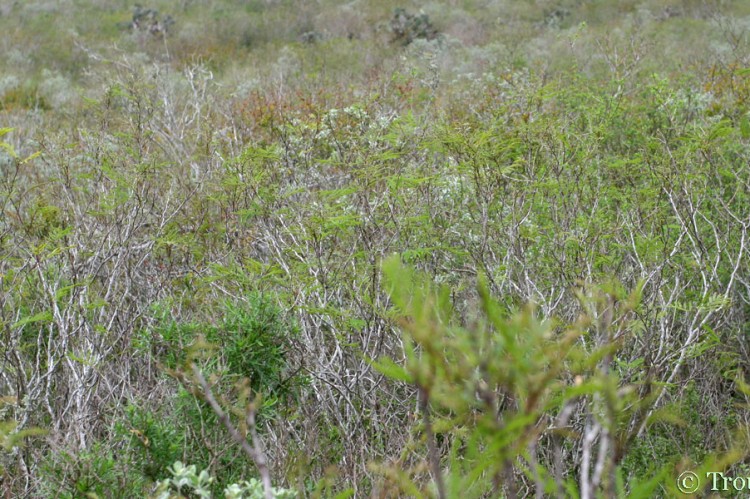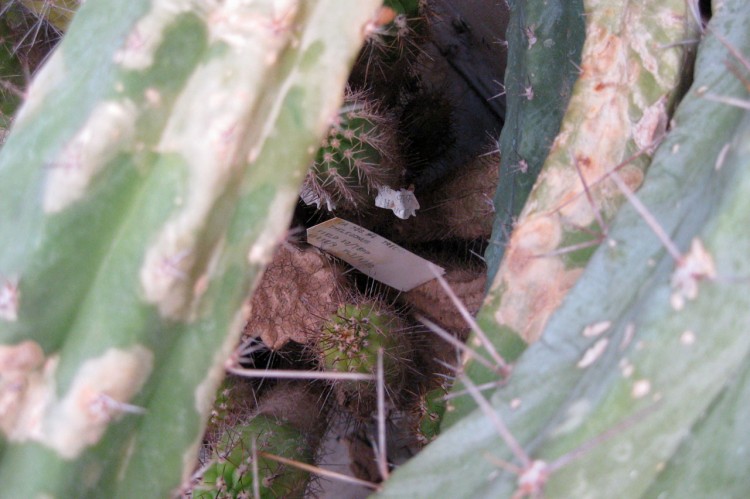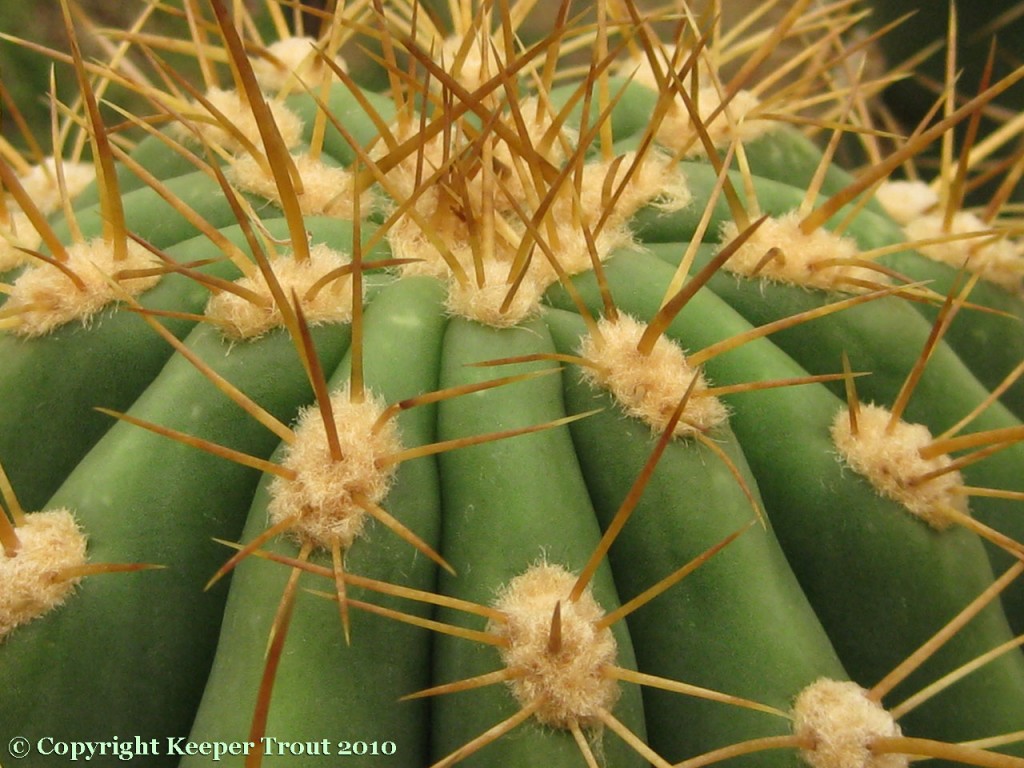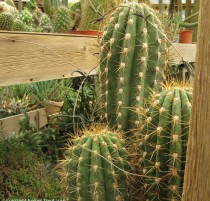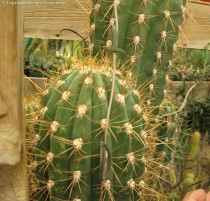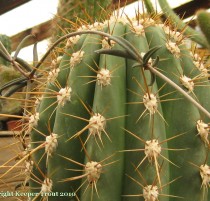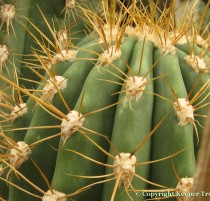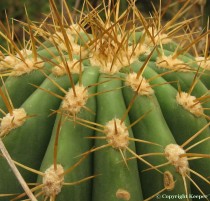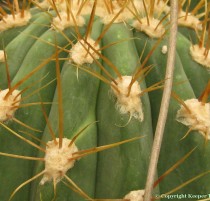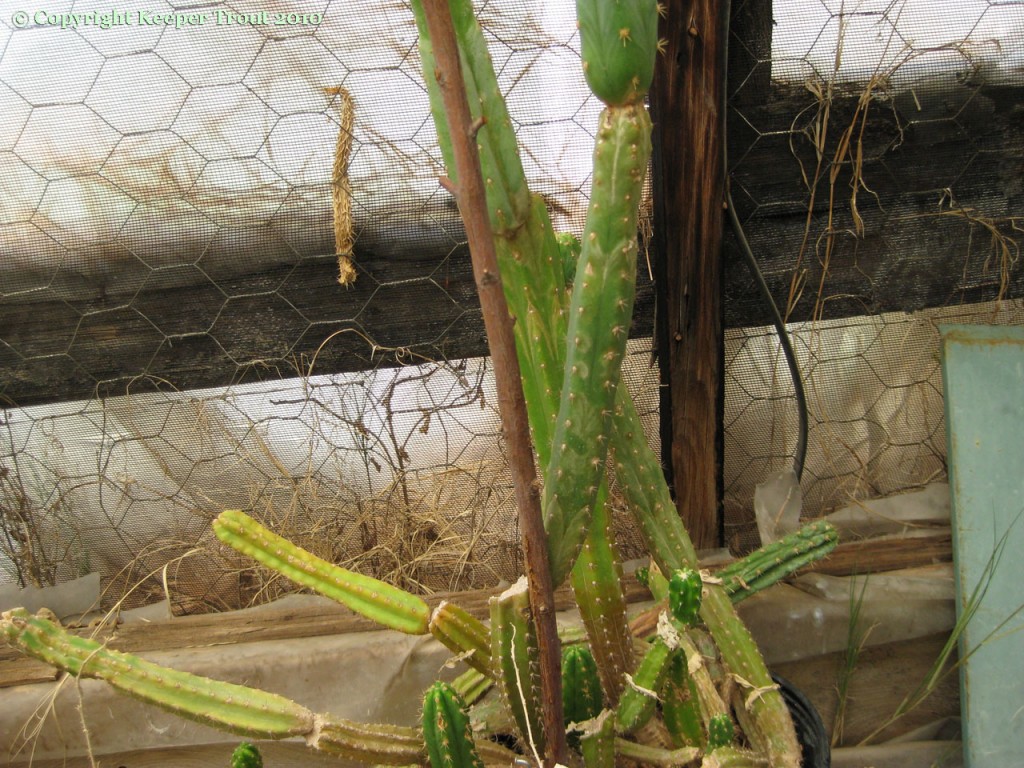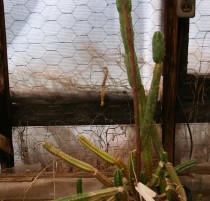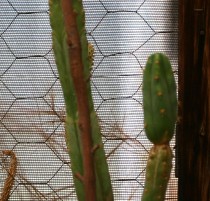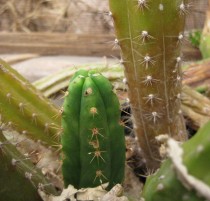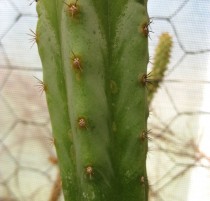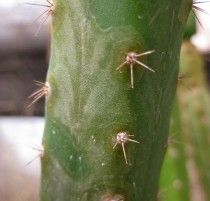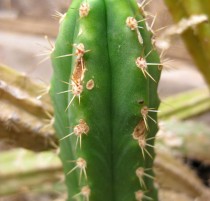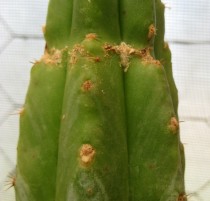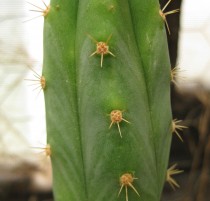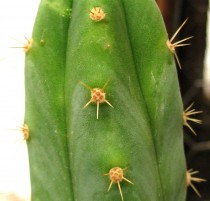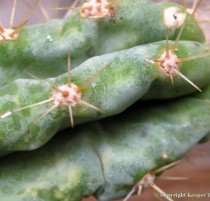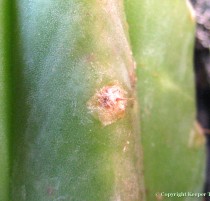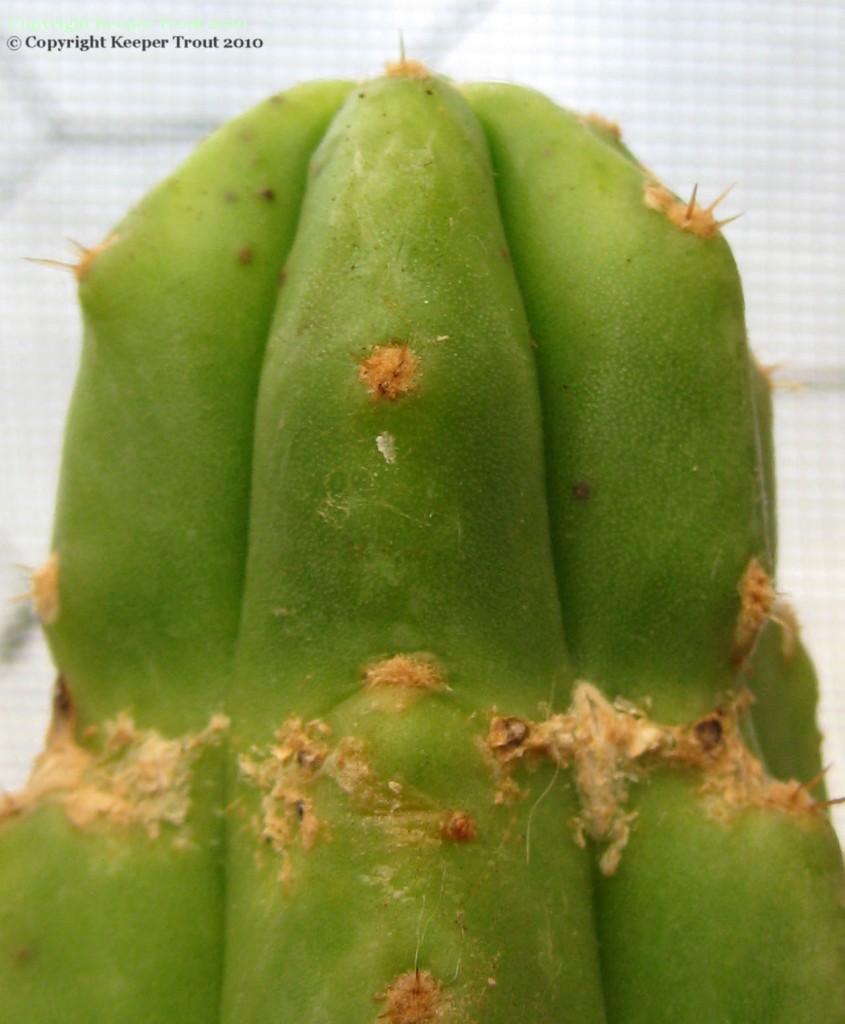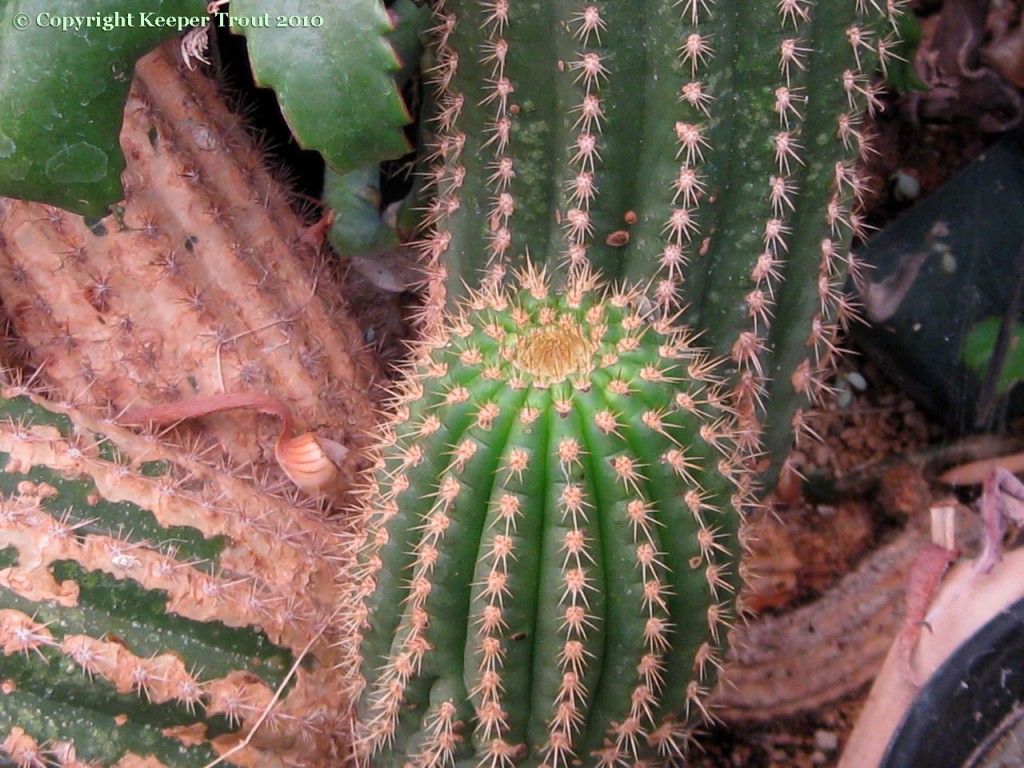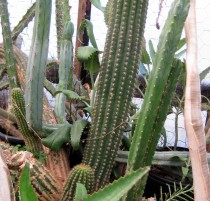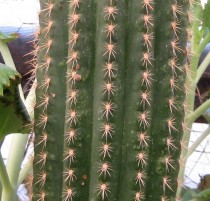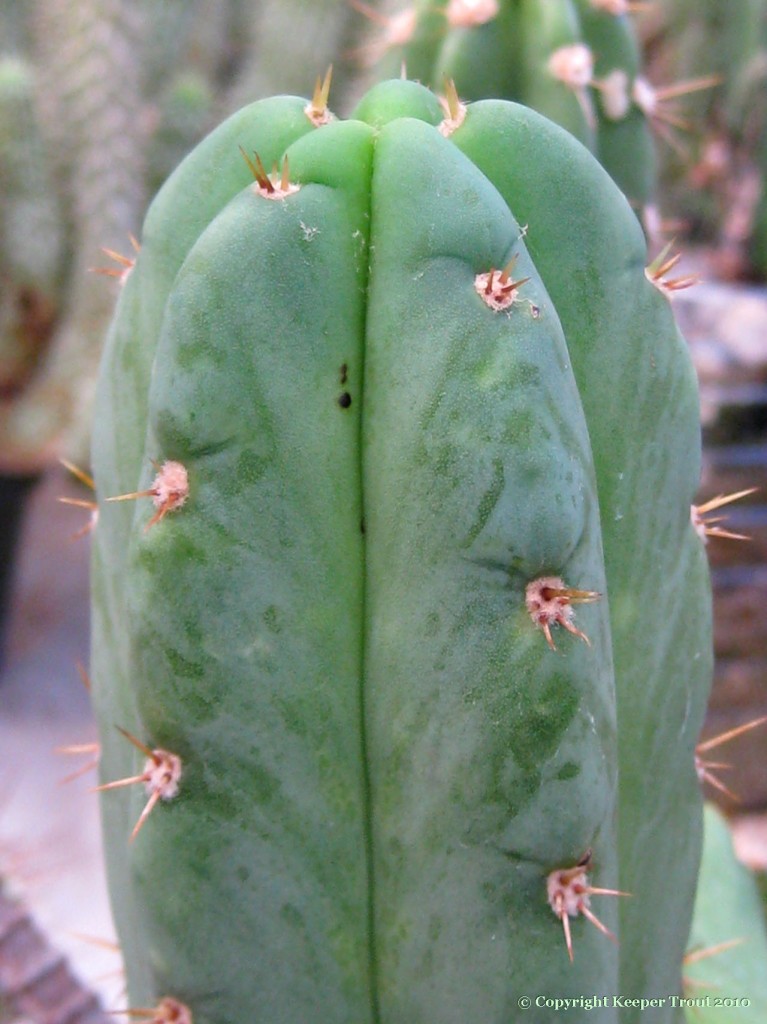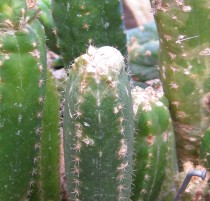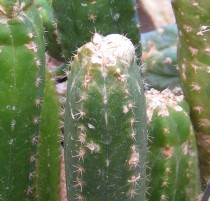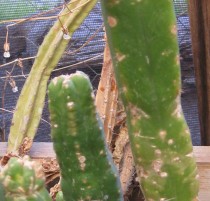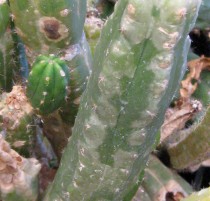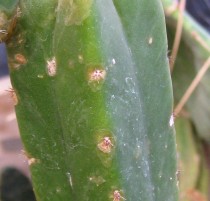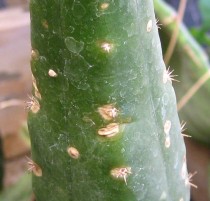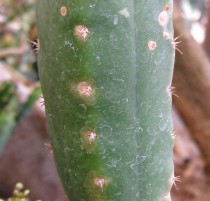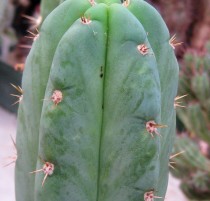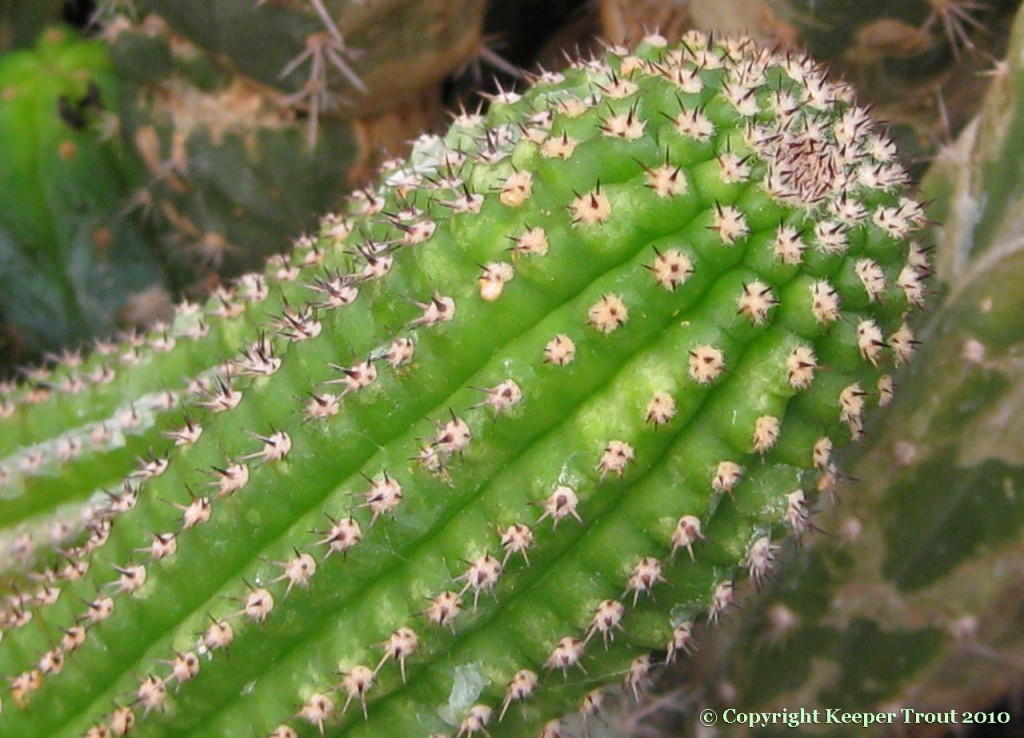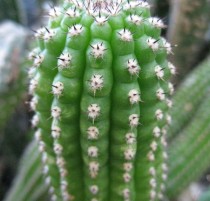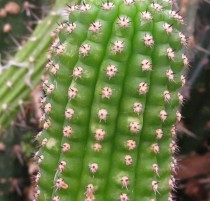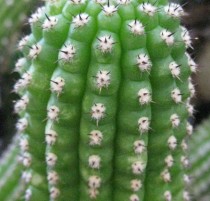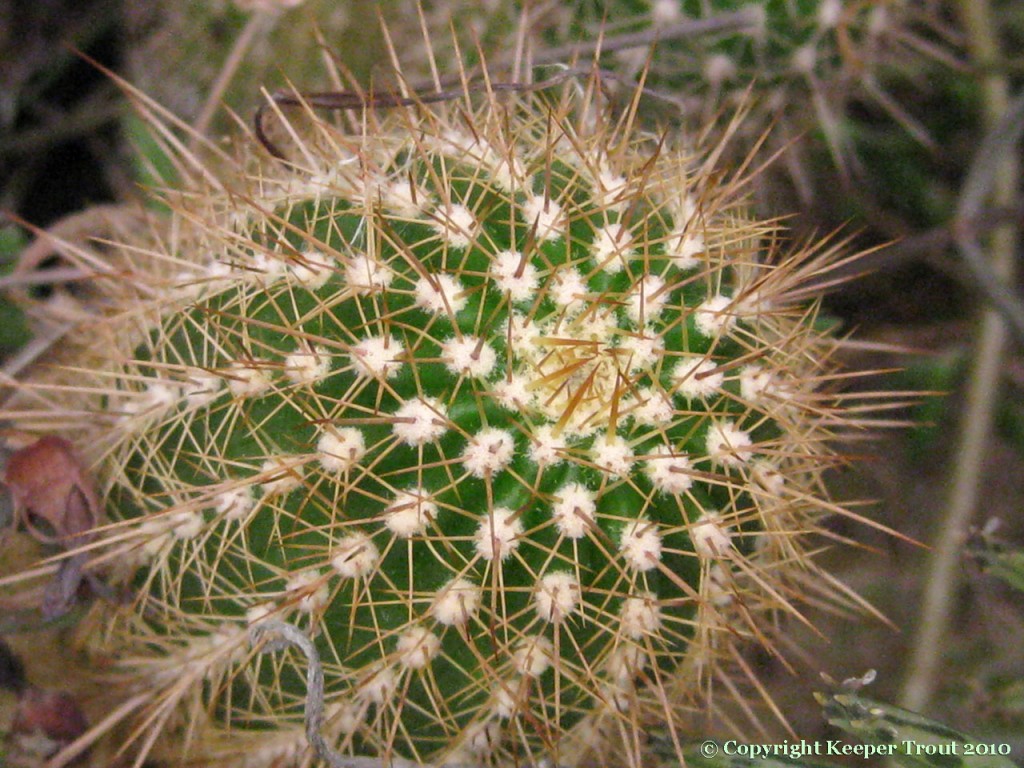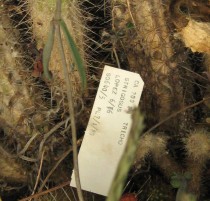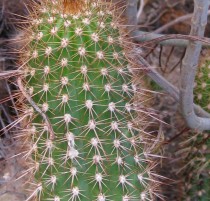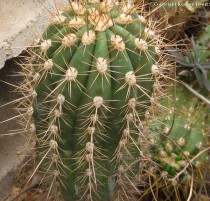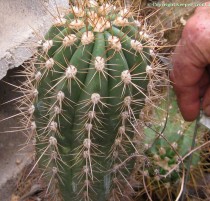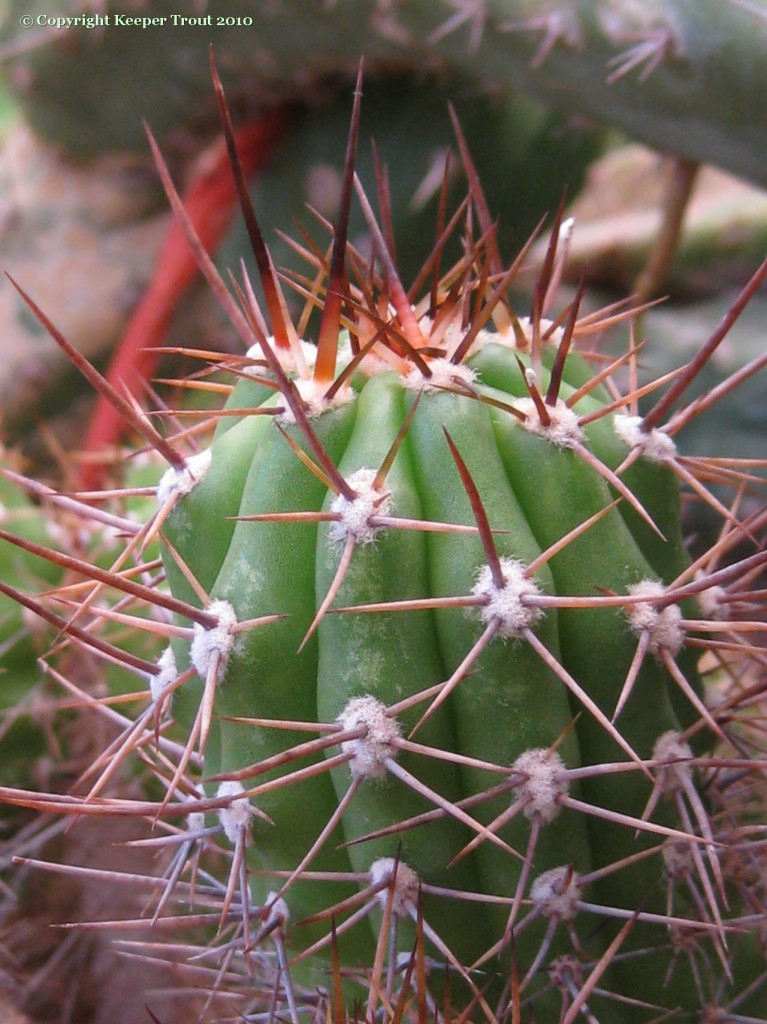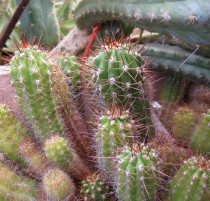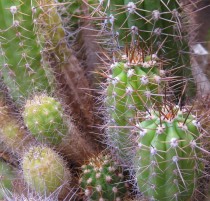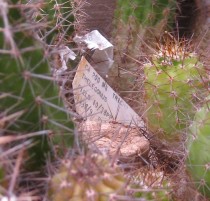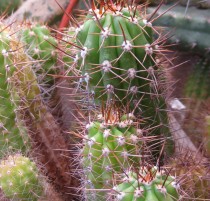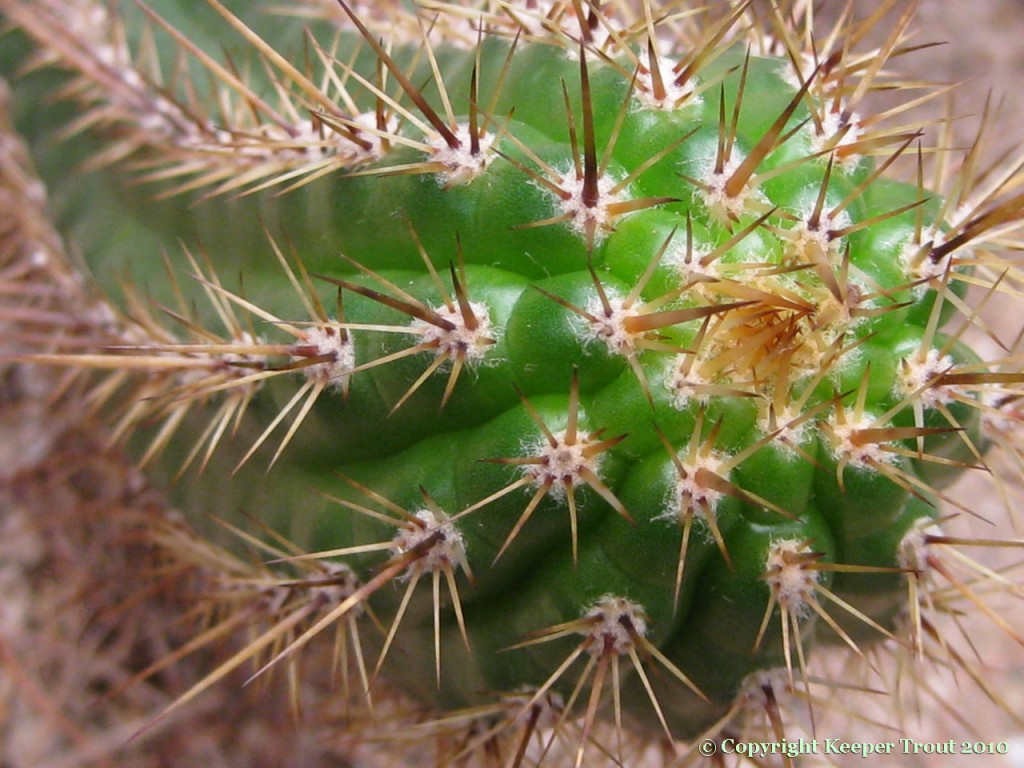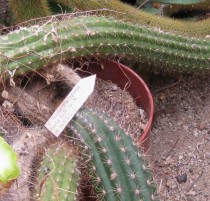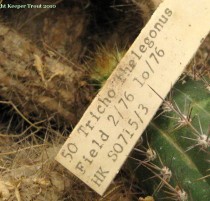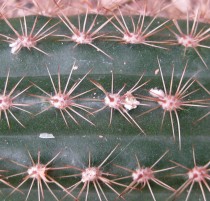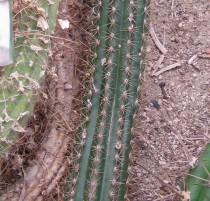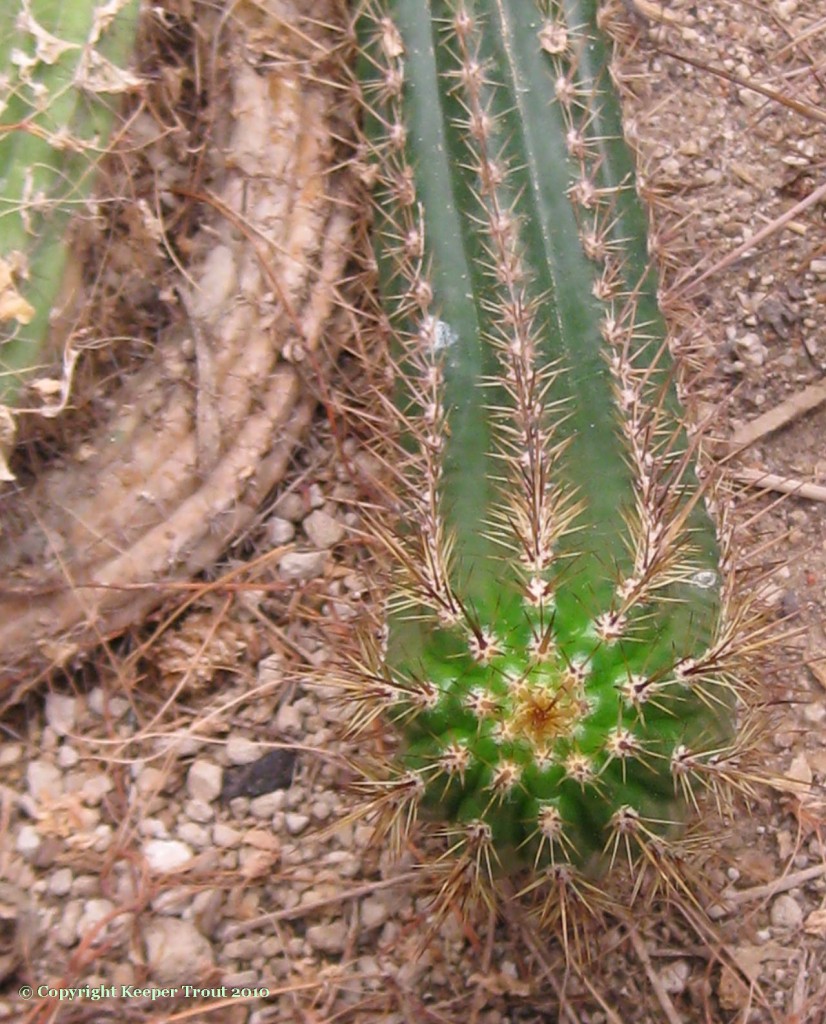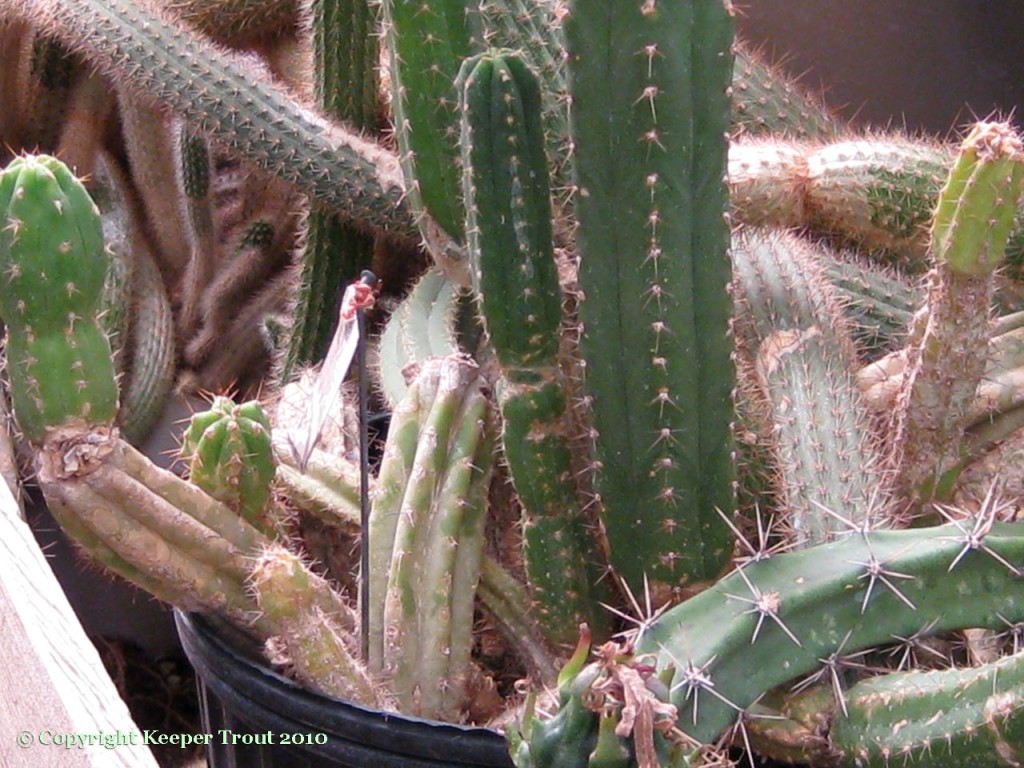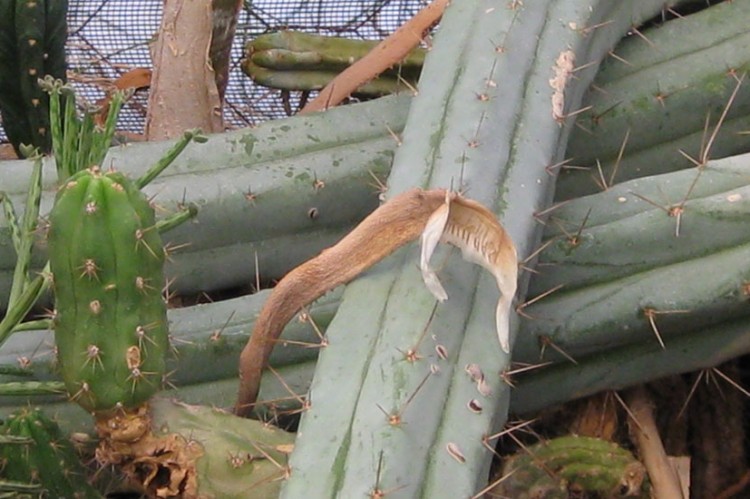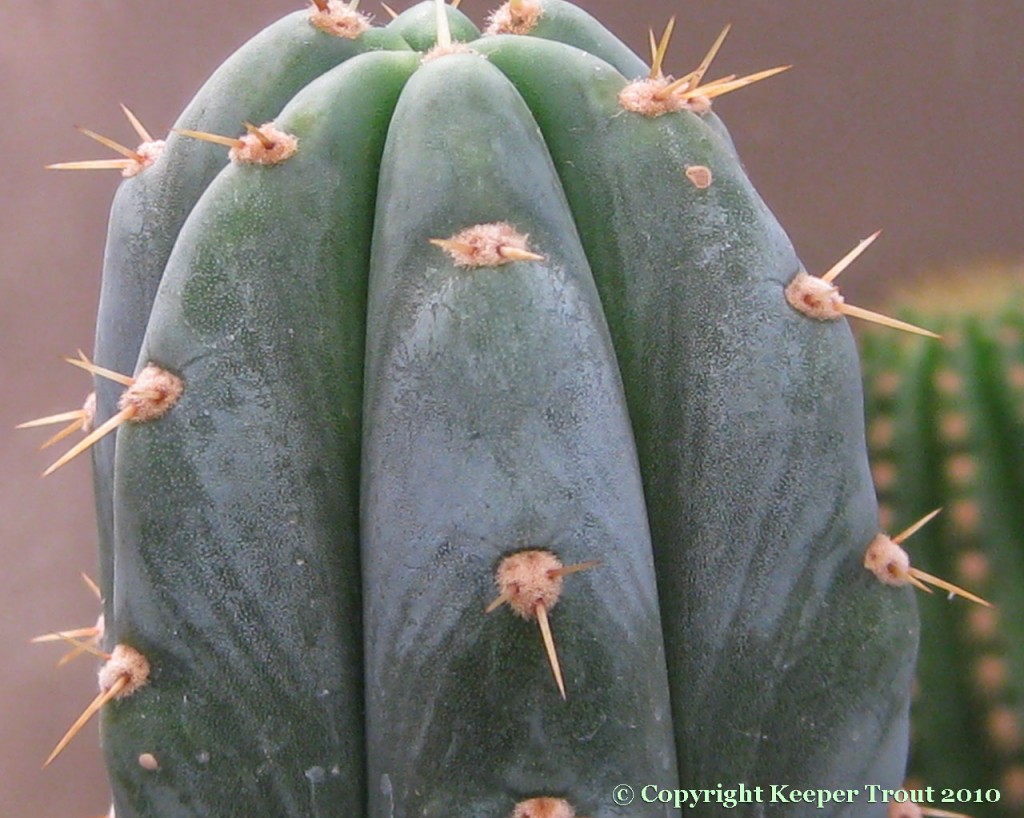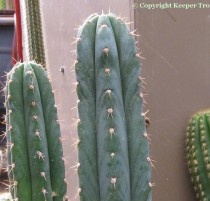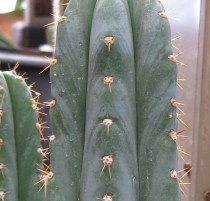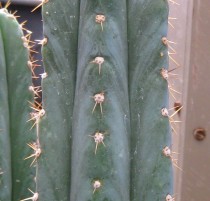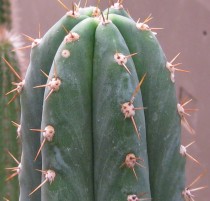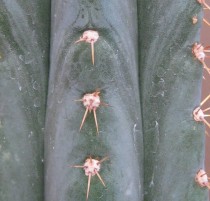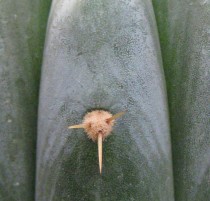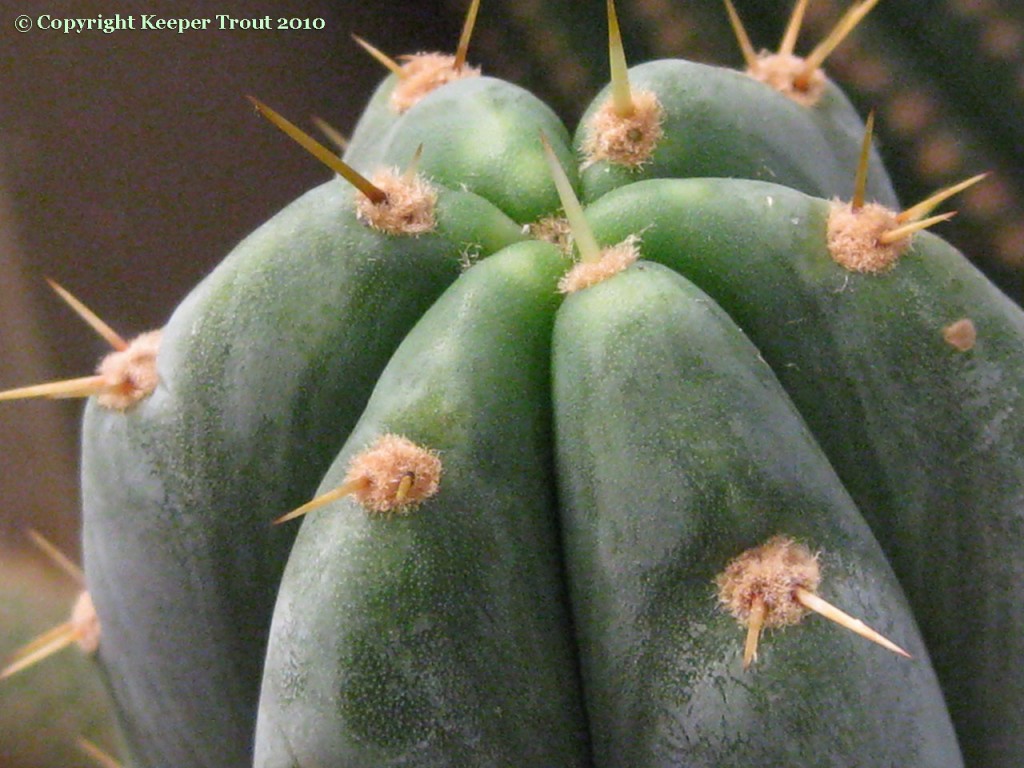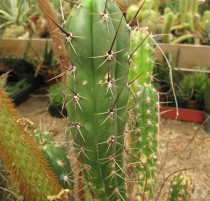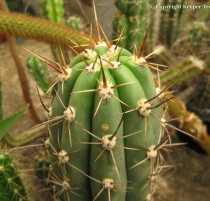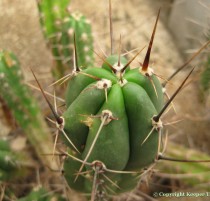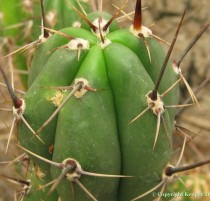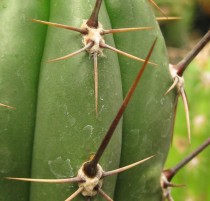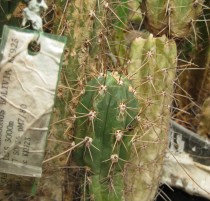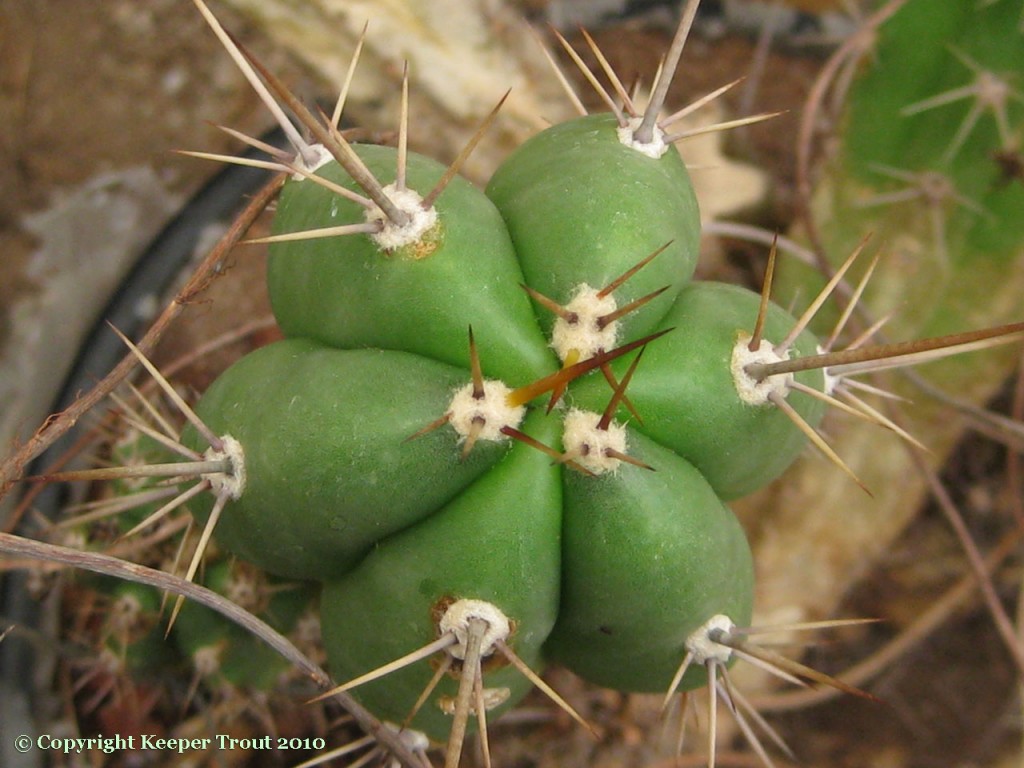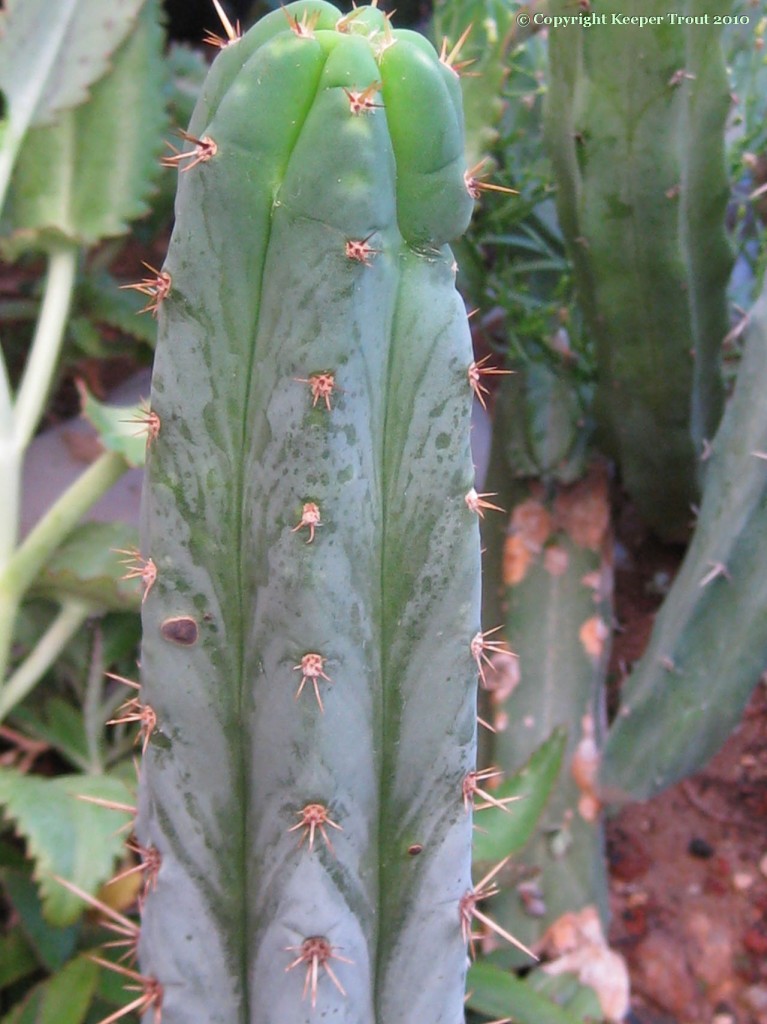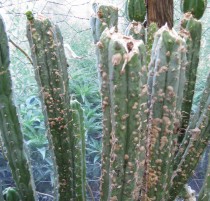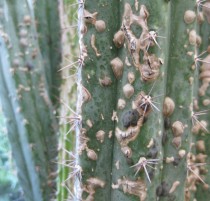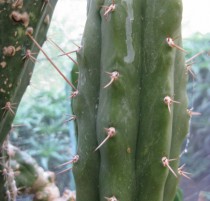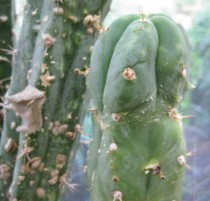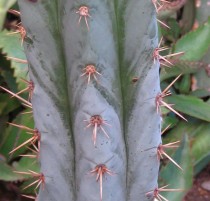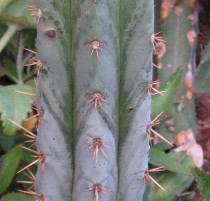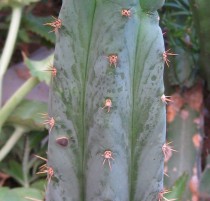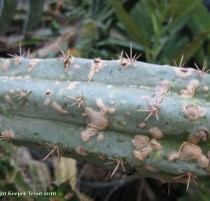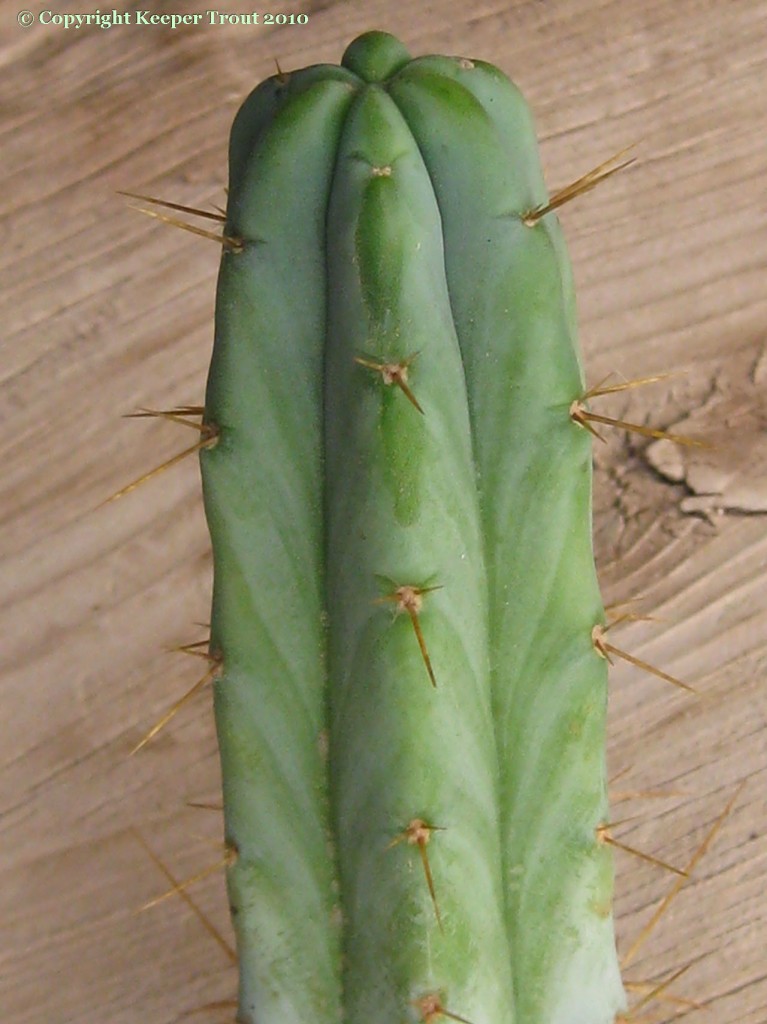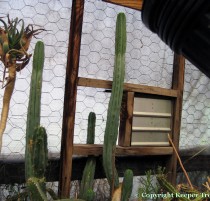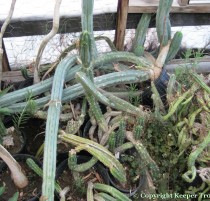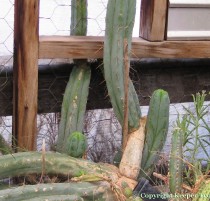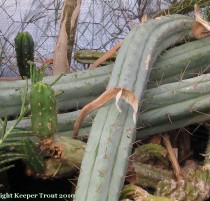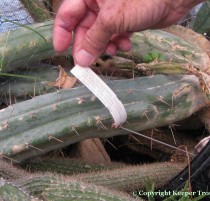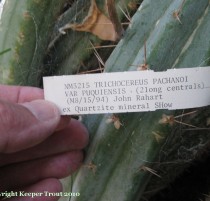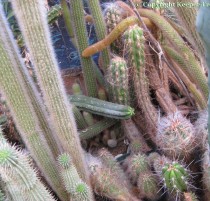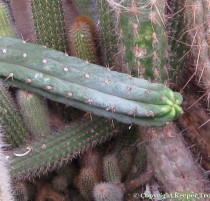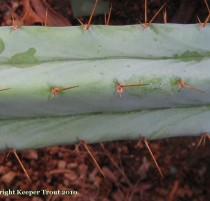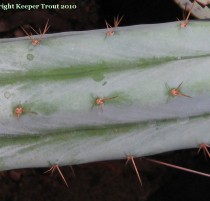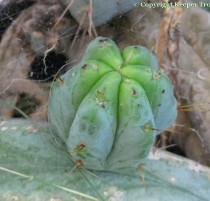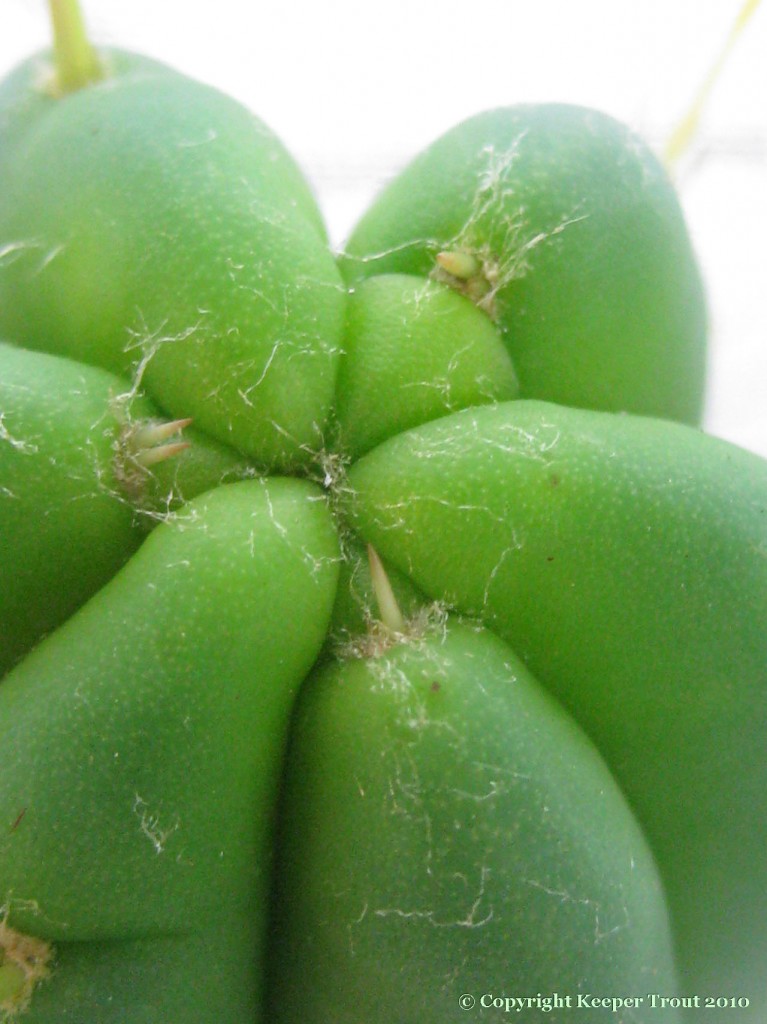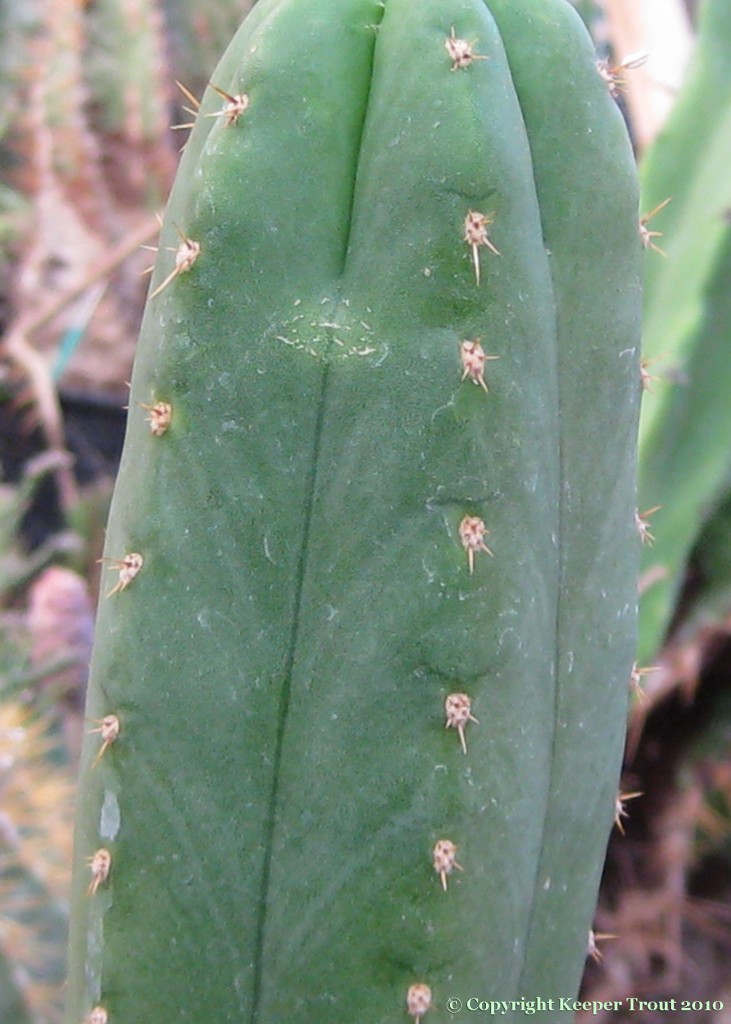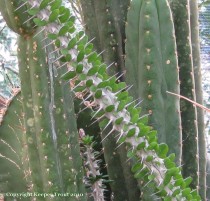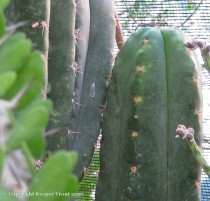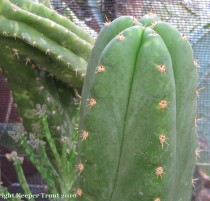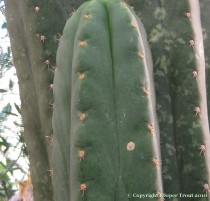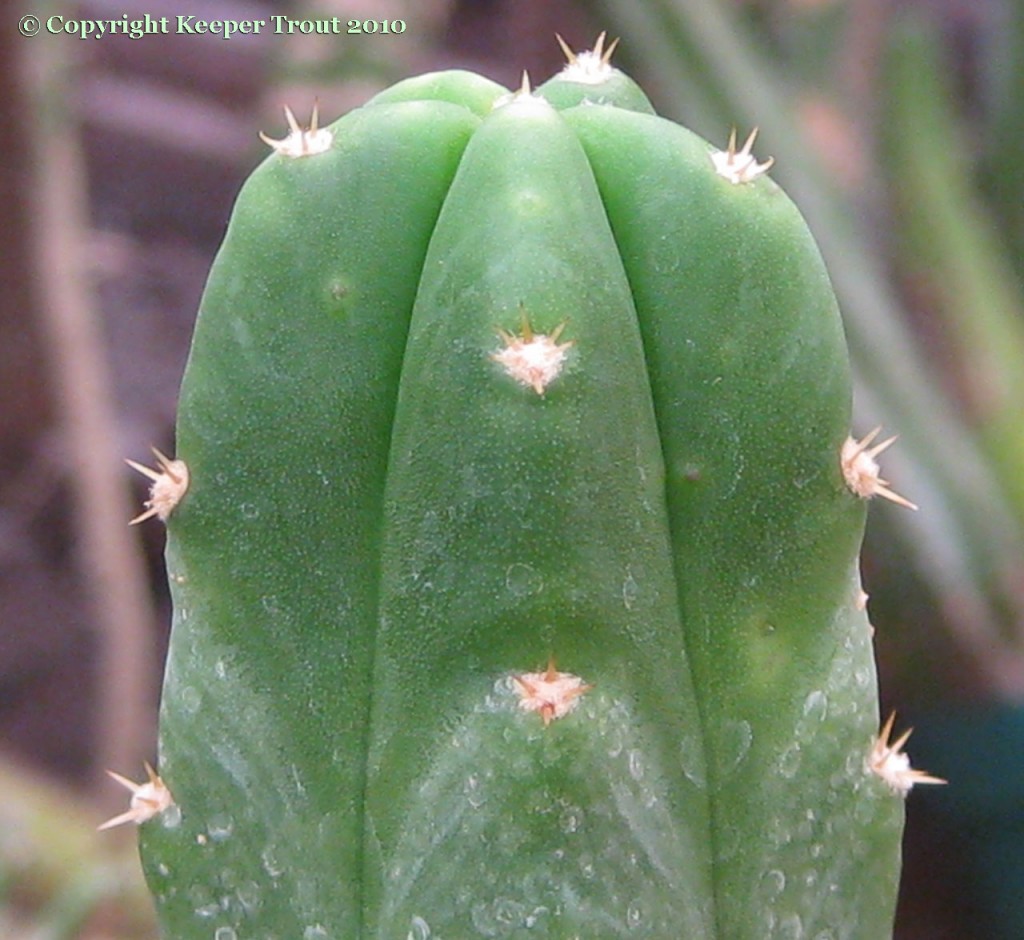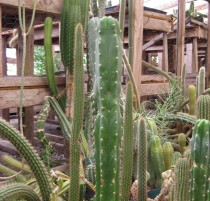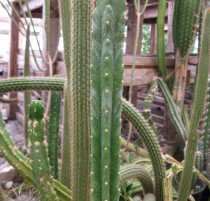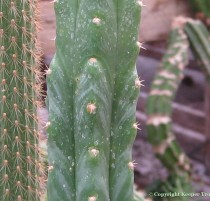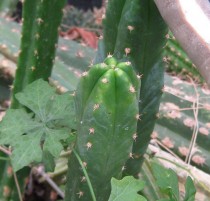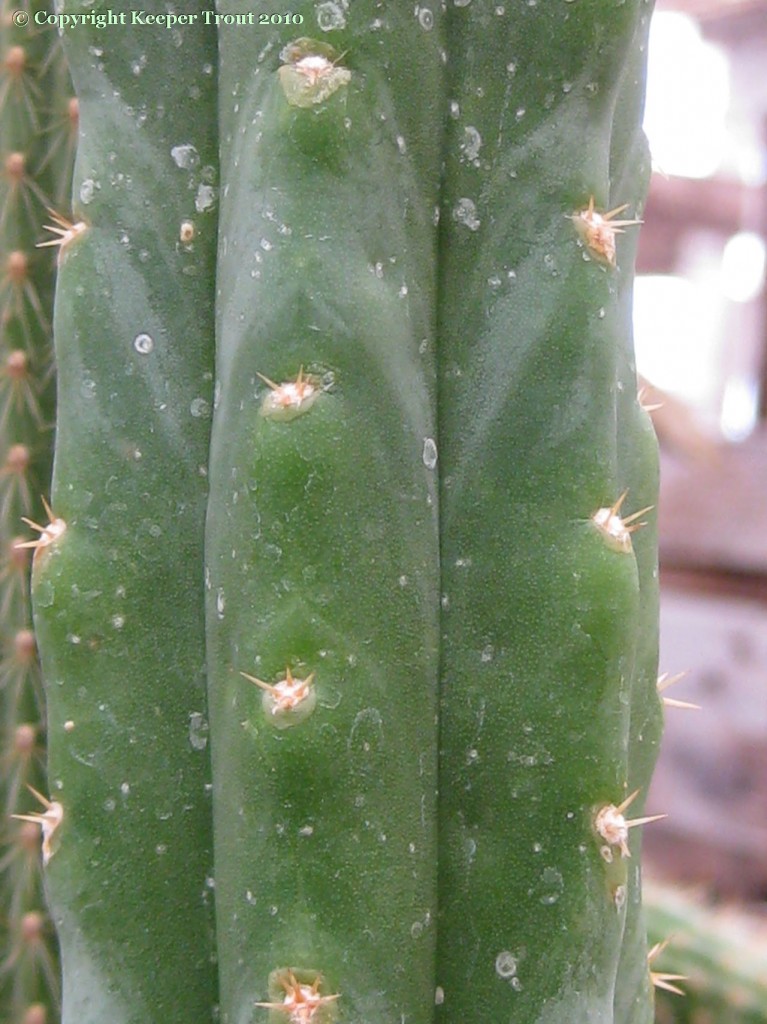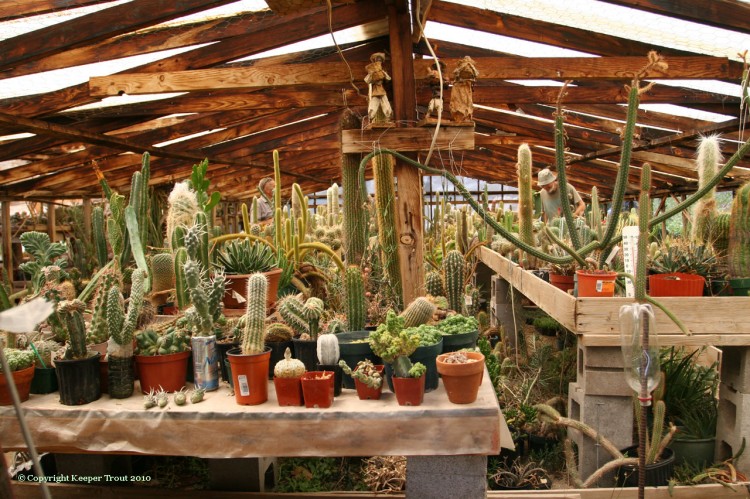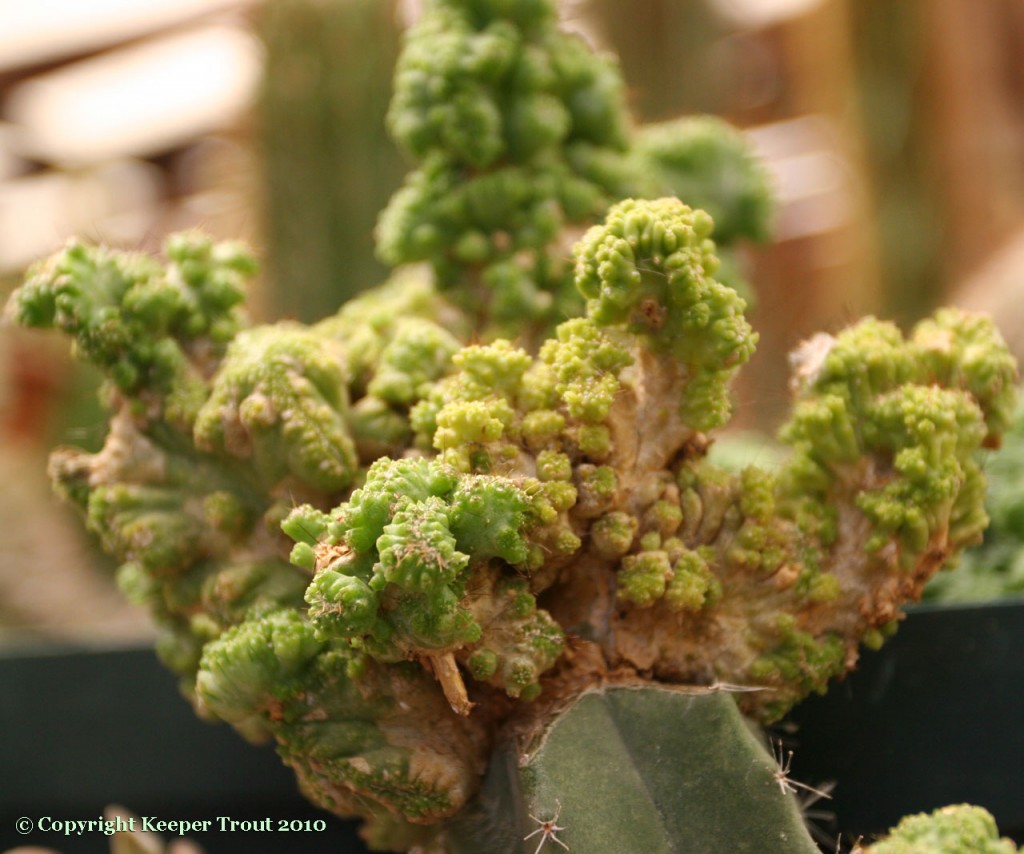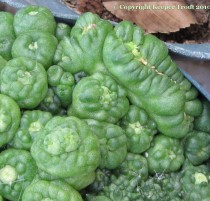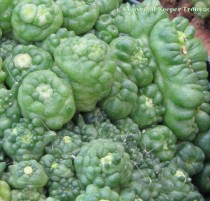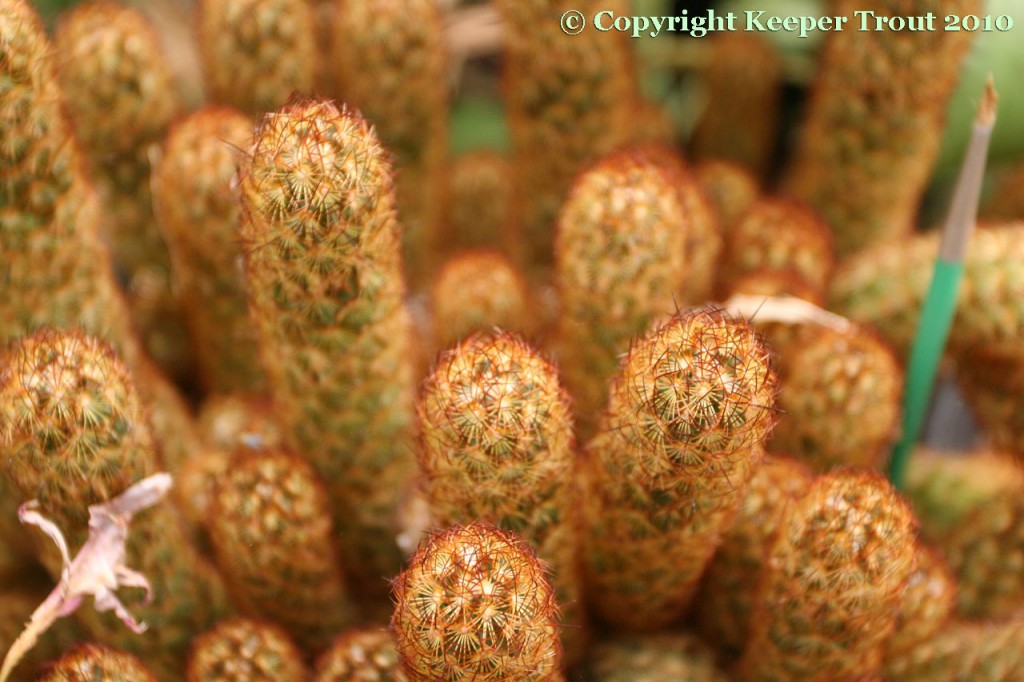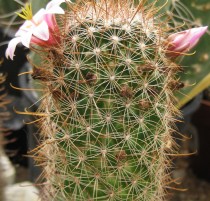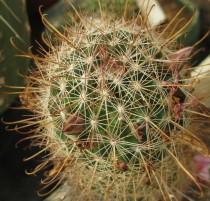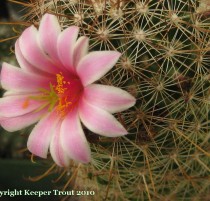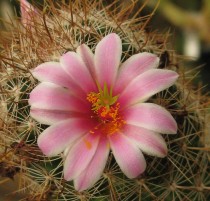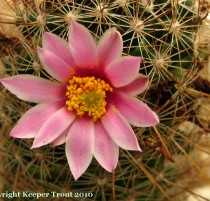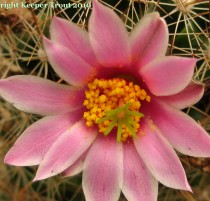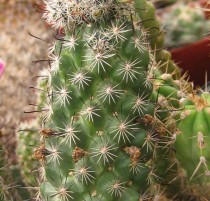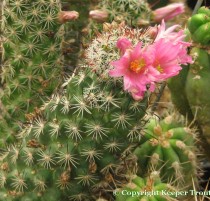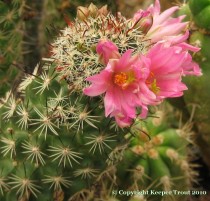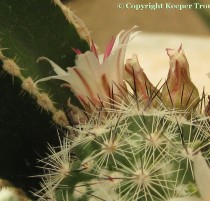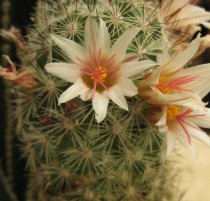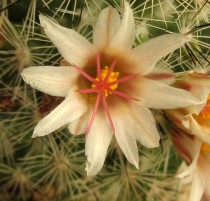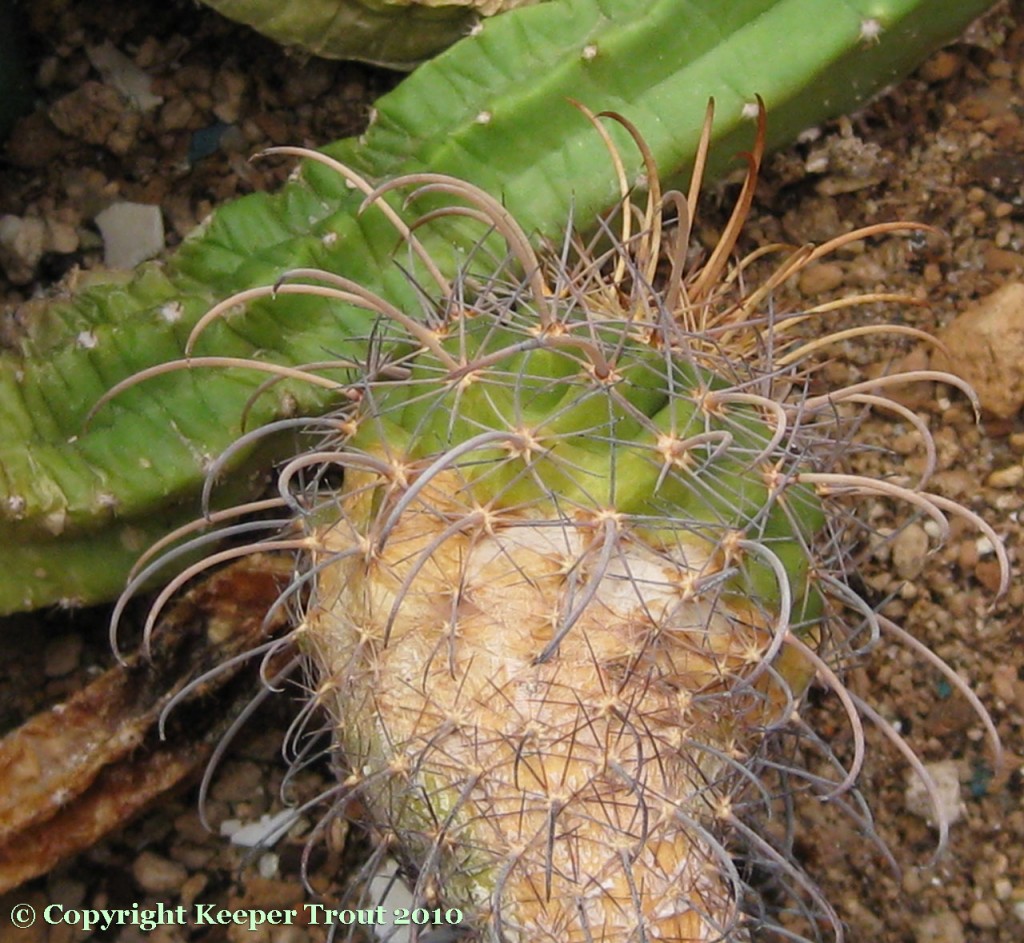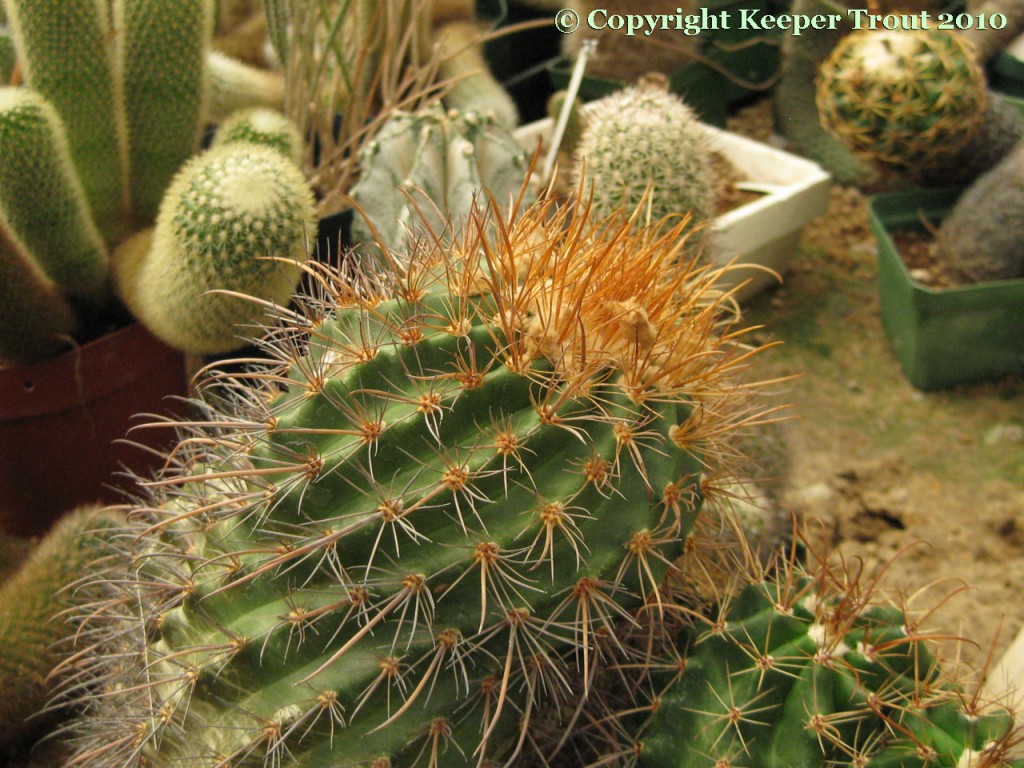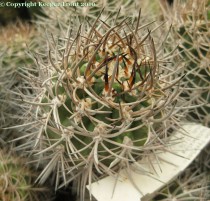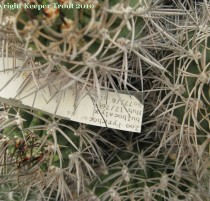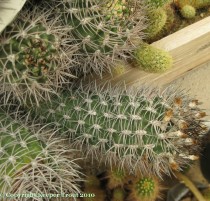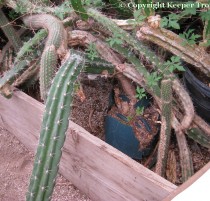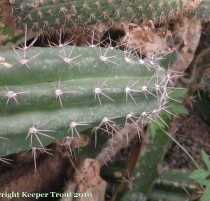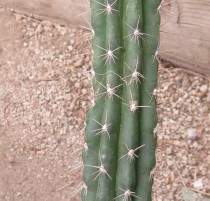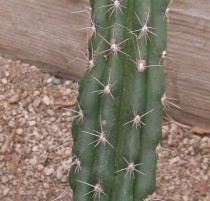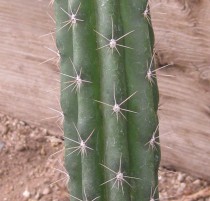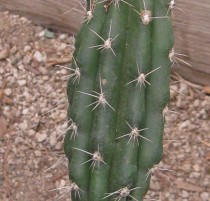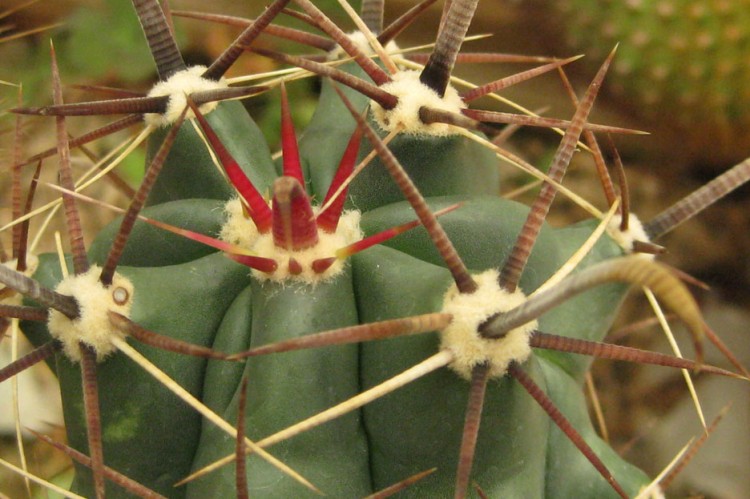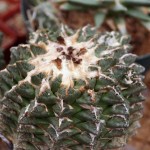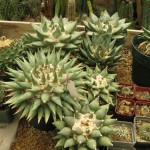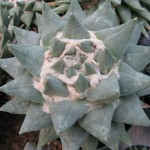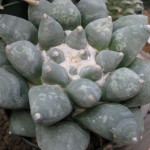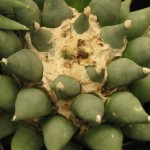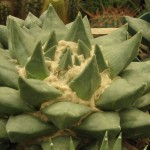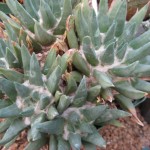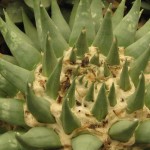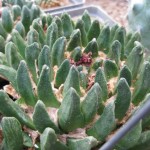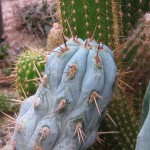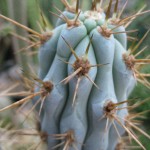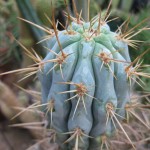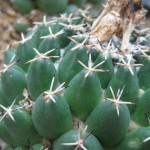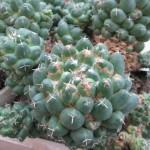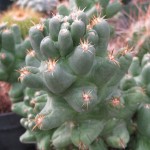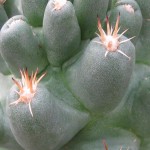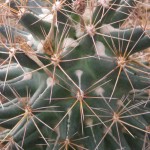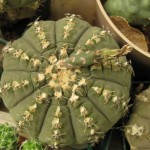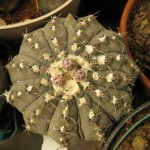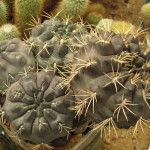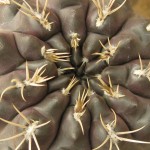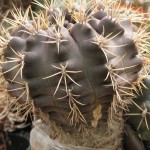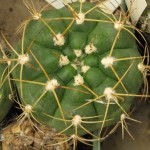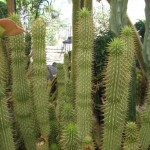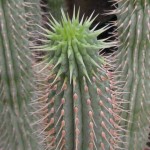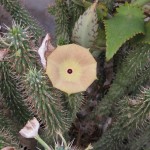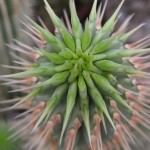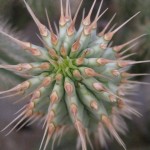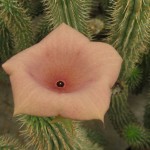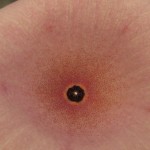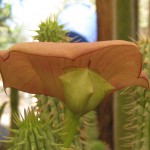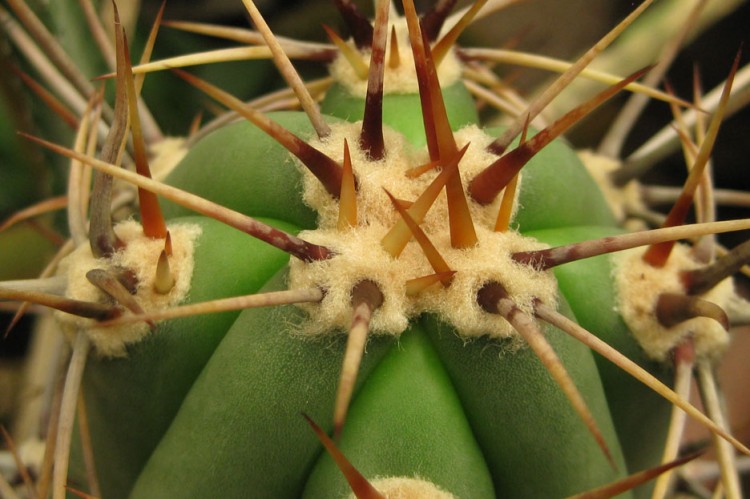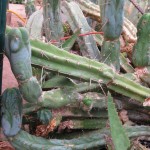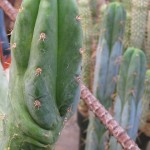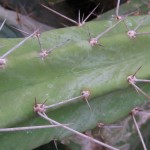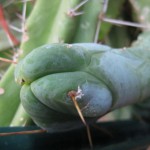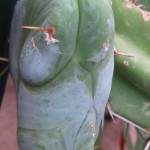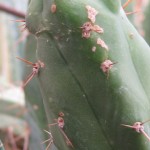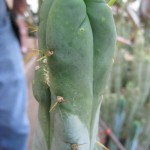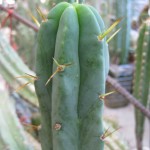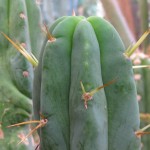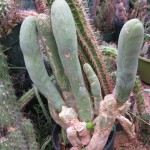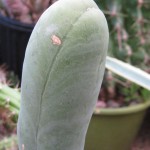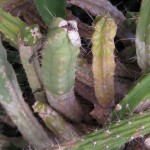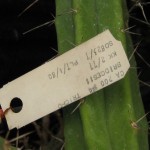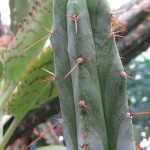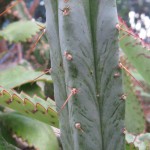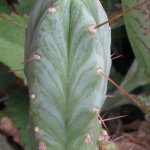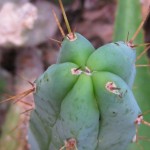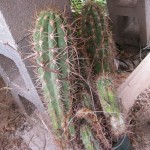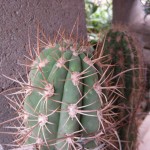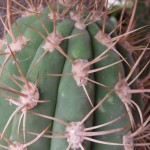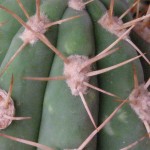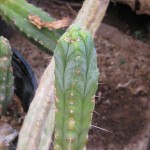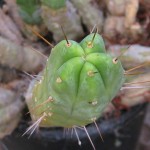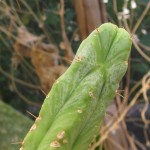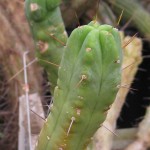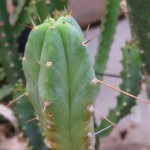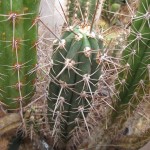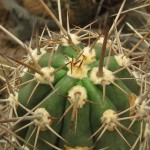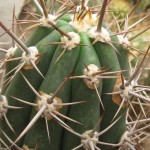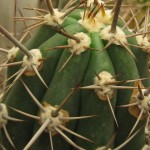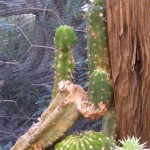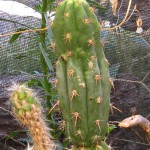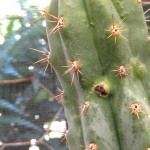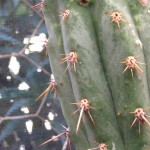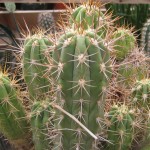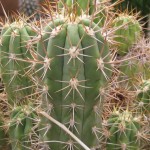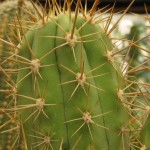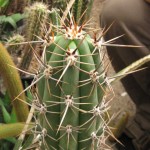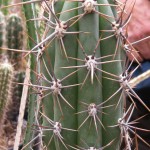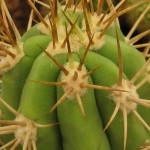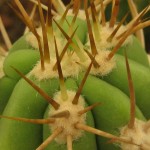Please view this page at http://sacredcacti.com/blog/acacia/ .
It has been expanded.
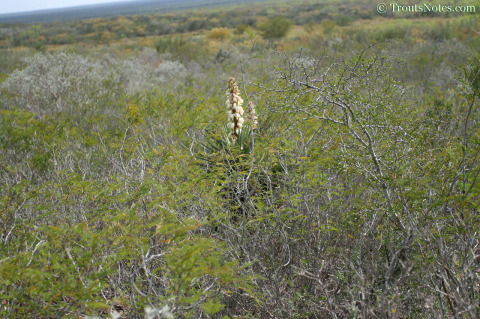
Brush country on the Bordas Escarpment in Jim Hogg County, Texas
A. berlandieri is on the front left, and beyond, with A. rigidula on right
Questions & comments concerning the analysis of Acacia berlandieri & Acacia rigidula
Acacia (Senegalia) berlandieri (description & illustrations)
Acacia (Vachellia) rigidula (description & illustrations)
In 1997, and then again in 1998, some almost unbelievable news rippled awkwardly through the world of plant science. Methamphetamine had just been reported from two abundant Acacia species that were already well-known for producing alkaloids involved with livestock problems.
The new information was then echoed far more loudly and unquestioningly through the counterculture, and in a flurry of news reports, and by the indexers & assemblers of the various reference databases on phytochemicals and naturally occurring compounds. It soon began appearing in works on toxicology, plant chemistry and drug issues. [A very few examples: T. Garland & A.C. Barr (eds.) 1998 Toxic Plants and Other Natural Toxicants (with a chapter by Clement & Forbes), G.E. Burrows & R.J. Tyrl 2012 Toxic Plants of North America, E. Eich 2008 Solanaceae and Convolvulceae: Secondary Metabolites, J.M. Hagel et al. 2012 Trends in Plant Science, 17 (7): 404-412, “Biosynthesis of amphetamine analogs in plants”, G.H. Rassool 2009 Alcohol and Drug Misuse, & T.R. Kosten 2012 Cocaine and Methamphetamine Dependence.]
Questions and conversations also rapidly proliferated in online discussions among people interested in drug abuse – both those with interests in its prevention and those who were interested in learning more about the possible potentials for human ingestion of the ‘new’ drug plants.
In the case of Acacia rigidula, this report also fueled a minor explosion of commercial weight-loss products that included this plant, at least in the list of ingredients on their label.
What made the news even more astonishing was that it was not just meth that was reported to be in those Acacia leaves, but also amphetamine and a handful of synthetic substituted amphetamines never before been observed in nature.
Other novelties making their first appearance as natural Acacia phytochemicals included a patented & FDA approved pharmaceutical, the tricyclic antidepressant Nortriptyline, and a putative neurotoxic agent, the synthetic fragrance molecule Musk ambrette.
They were further described to be accompanied by an almost bewildering array of amines. For some of the familiar alkaloids this marked their first report outside of the family Cactaceae. That included mescaline, trichocereine and four isoquinolines. All of which were reported to occur along with dopamine, candicine, dimethyltryptamine (DMT) and nicotine as part of the nearly four dozen compounds that were said to have been identified in the two Acacia species.
Simple phenethylamines, DMT and nicotine are well known from other Acacia species but the crazy pharmacological cocktail that was conjured in people’s minds by those two reports certainly stirred up a bit of attention from both the peanut gallery and from assorted professional interests.
See Endnote A at the bottom of this page for some search result numbers.
In a conversation occurring a year or so after the second publication had occurred, Sasha Shulgin questioned the soundness of my inclusion of the information in the 1999 printing of Cactus Chemistry By Species. Sasha brought to my attention some odd discrepancies concerning those two accounts by Clement. The first and most concerning to Sasha, despite repeated efforts apparently none of the authors had responded to his contact attempts. In Sasha’s mind, the failure of any professional researcher to respond to questions from one of their peers was a warning sign that problems existed for the report. Organic chemists typically welcome interest in their work being expressed by other organic chemists.
Sasha further claimed to have noticed that not all the novel compounds that their two papers purported were synthesized as reference materials have a published synthesis. Interest in learning more details about the synthetic work was Sasha’s reason for his contact attempts. He eventually went on to dismiss the results of both papers entirely, and in an online Q&A column Sasha joked that dirty, perhaps recycled, laboratory glassware might be a possible although unlikely culprit; “even in Texas“.
(See Dear Dr. Shulgin [http://www.cognitiveliberty.org/shulgin/adsarchive/acacia.htm] for his exact comments in 2001.)
More recent work resulting from interest by the FDA, published in Pawar et al. 2014, was unable to detect the presence of mescaline, mescaline derivatives or any of the purported amphetamines and isoquinolines. With only the exception of tryptamine & one of the four samples of bark showing a trace of N-methyltrypamine (neither of which are surprising for an Acacia species) none of the novelties reported by Clement were observed.
It did largely support the prior analytical work in the handful of papers previously published by Adams, Camp and coworkers but deviated by not finding N-methylphenethylamine to be the major alkaloid in any of their samples. Pawar found it to be lacking in half of their samples and present only as trace amounts in the other two.
The novel results in Clement’s accounts still need replication by someone.
Dr. Clement has commented about being unaware of any controversy or questions existing about their work but this appears to be in conflict with two professional workers (Dr. Shulgin & Dr. Terry) who voiced comments to me about their experiences with Dr. Clement while they were still trying to learn answers for the questions they noticed. An interview with Dr. Clement by Natural Products Insider in 2013, in which she defended their reported data and described the elaborate precautions that were said to be necessary in order to produce the same results. (Such as performing the extraction and solvent removal using the protection of an argon blanket.)
And to be fair to Dr. Clement, it is noteable that no one at FDA actually tried to replicate her work rather than apparently rejecting the precautions taken to prevent degradation as being unnecessary. I may agree with the conclusions of her critics but I would also suggest that, thus far, no one can legitimately claim that anyone actually attempted to replicate what was reported in Clement et al. 1997 and 1998. For the most part, Clement began by extracting fresh (1997) and fresh and still frozen (1998) plant materials, whereas Pawar et al 2014 freeze-dried their fresh plant samples. (Clement had used freeze drying of fresh frozen leaves for quantification of N-methylphenethylamine.) Pawar also omitted the use of argon which Clement presented as important to prevent degradation of alkaloids. However, Pawar’s interest was not an academic one trying to reproduce Clement’s results but rather was focused on establishing what compounds were in the diet products they also tested and whether those contents came from this plant. Their point of study really had no reason to respect the concerns voiced about the degradation of alkaloid content. And to be fair to her critics, Clement did not describe the needs for such protection within her two accounts with nearly the same amount of details as she did within that interview in 2013. (The pertinent comments from those papers as concerns argon can be found quoted farther below.)
In that interview (if you have not already done so, you might want to read it before continuing) there are a number of things the careful reader might notice are peculiar for sake of not being mentioned at all, such as their discovery of a wealth of novel Acacia alkaloids.
There are also some words included in that interview that are worth noticing:
“The early season guajillo was unremarkable to Clement and her team. “The extraction was clean (bright green extract, easily partitioned with acid and base extraction),” Clement reported. “The analysis was relatively straightforward; we found terpenes, a few simple phenols and scant traces of β-phenethylamine, but no detectable N-methyl-β-phenethylamine, which had previously been reported.” However, work on late season guajillo was a different story. “The initial methanol extract was a very dark green, almost black color,” she noted, adding the team realized these extracts had to be handled much more carefully due to extreme vulnerability to degradation. “After we began using an argon blanket, this degradation was no longer a problem; argon is a much more forgiving inert atmosphere than nitrogen.” The end result was positive identification of N-methyl-β-phenethylamine; N,N-dimethyl-β-phenethylamine; and tyramine in these fractions.”
INSIDER, November 26, 2013 written by Steve Myers.
Online at http://www.naturalproductsinsider.com/articles/2013/11/blackbrush-scapegoats-or-shaky-goats.aspx (Accessed on 17 May 2014; still online in January 2015)
Compare those comments to their results in the tables below. In particular, compare what was highlighted in bold (by me) in the text above & in the tables below (and compare her words above about the need for argon to the comments farther below under Clement et al. 1997, Clement et al. 1998, Clement & Forbes 1998, & Clement 2013).
Acacia berlandieri Bentham (these results need to be questioned)
| Compound | Spring | Late fall |
| (all via gc-ms) | ppm | ppm |
| Phenethylamine | 991.3 | 1390.0 |
| N-Methylphenethylamine | 1702.7 | 3742.2 |
| N,N-Dimethylphenethylamine | 99.1 | 604.4 |
| N,N,N-Trimethylphenethylammonium hydroxide* | nd | 23.6 |
| Amphetamine | 3.1 | 10.1 |
| Methamphetamine | 20.1 | 11.5 |
| N,N-Dimethyl-α-methylphenethylamine | 45.6 | 229.7 |
| p-Hydroxyamphetamine | 8.0 | 7.3 |
| p-Methoxyamphetamine | nd | 35.7 |
| Tyramine | 367.2 | 1263.4 |
| N-Methyltyramine | 188.5 | 745.7 |
| Hordenine | 9.2 | 333.1 |
| Candicine* | nd | 35.1 |
| Dopamine | 3.6 | 25.3 |
| N-Methyldopamine | 1.9 | 10.8 |
| N,N-Dimethyldopamine | nd | nd |
| 3-Methoxytyramine | 2.6 | 15.3 |
| Mescaline | 4.9 | 35.7 |
| N-Methylmescaline | 3.2 | 30.2 |
| Trichocereine | nd | 28.1 |
| 3,4,5-Trimethoxyphenethyl-N,N,N-trimethylammonium hydroxide* | nd | 13.2 |
| 3,5-Dimethoxytyramine | 2.7 | 43.4 |
| 3,4-Dimethoxy-5-hydroxyphenethylamine | 11.4 | 40.9 |
| β-Methoxy-3,4-dihydroxy-5-methoxyphenethylamine | nd | 30.2 |
| 3,4-Dimethoxy-α-methyl-5-hydroxyphenethylamine | 2.0 | 47.2 |
| Nicotine | 39.6 | 108.3 |
| Nornicotine | 19.2 | 72.5 |
| Anhalamine | 4.9 | 39.6 |
| Anhalidine (N-Methylanhalamine) | 2.9 | 40.9 |
| Anhalonidine | 2.7 | 46.8 |
| Mimosine, methyl ester | 10.6 | 24.2 |
| 3α-Cumyl-1,3,4-oxadiazolidine-2,5-dione | 308.4 | 420.9 |
| Nortriptyline | 19.8 | 71.5 |
| Musk ambrette | 26.5 | 27.3 |
Clement et al. 1997
Acacia rigidula Bentham (these results need to be questioned)
| Compound | Spring | Late Fall |
| (all via gc-ms) | ppm | ppm |
| 2-Cyclohexylethylamine | 0.8 | 35.2 |
| N-2-Cyclohexylethyl-N-methylamine | 1.2 | 47.1 |
| Phenethylamine | 872.3 | 1135.7 |
| N-Methylphenethylamine | 2314.6 | 5264.8 |
| N,N-Dimethylphenethylamine | 123.6 | 724.5 |
| Amphetamine | 6.7 | 11.8 |
| Methamphetamine | nd | 12.4 |
| N,N-Dimethyl-α-methylphenethylamine | 57.6 | 394.2 |
| p-Hydroxyamphetamine | 2.1 | 6.9 |
| p-Methoxyamphetamine | nd | 15.7 |
| Tyramine | 459.1 | 1699.2 |
| N-Methyltyramine | 237.4 | 1237.6 |
| Hordenine | 6.4 | 533.8 |
| Dopamine | 8.9 | 36.1 |
| N-Methyldopamine | 0.5 | 8.2 |
| N,N-Dimethyldopamine | 11.2 | 44.6 |
| 3-Methoxytryamine | 1.8 | 12.9 |
| N-Methyl-3-methoxytyramine | 3.4 | 28.4 |
| 3-Hydroxy-4-methoxyphenethylamine | 15.8 | 163.2 |
| N-Methyl-3-hydroxy-4-methoxyphenethylamine | 19.2 | 184.7 |
| 3,4-Dimethoxyphenethylamine | 1.3 | 6.5 |
| N-Methyl-3,4-dimethoxyphenethylamine | 7.6 | 28.3 |
| 3,4,5-Trihydroxyphenethylamine | 1.6 | 12.4 |
| N-Methyl-3,4,5-trihydroxyphenethylamine | 0.3 | 1.9 |
| Mescaline | 3.4 | 27.5 |
| N-Methylmescaline | 1.8 | 35.3 |
| Trichocereine | 0.2 | 13.8 |
| 3,5-Dimethoxytyramine | 1.6 | 21.6 |
| 3,4-Dimethoxy-5-hydroxyphenethylamine | 15.6 | 57.1 |
| β-Methoxy-3,4-dihydroxy-5-methoxyphenethylamine | 4.6 | 22.1 |
| 3,4-Dimethoxy-α-methyl-5-hydroxyphenethylamine | 5.3 | 61.4 |
| Nicotine | 45.8 | 152.4 |
| Nornicotine | 23.4 | 84.3 |
| Tryptamine | 0.8 | 21.2 |
| N-Methyltryptamine | 4.6 | 54.9 |
| N,N-Dimethyltryptamine | 323.8 | 568.4 |
| Anhalamine | 9.6 | 48.7 |
| Anhalidine (N-Methylanhalamine) | 5.6 | 51.2 |
| Anhalonidine | 2.3 | 15.7 |
| Peyophorine | 3.8 | 43.4 |
| Pipecolamide | 872.8 | 978.2 |
| p-Hydroxypipecolamide | 241.6 | 353.1 |
| 1,4-Benzenediamine | 104.8 | 129.6 |
| 4-Methyl-2-pyridinamine | 341.5 | 567.3 |
Clement et al. 1998
This was the statement that had caught Sasha’s attention:
“[…] mass spectral library and the NBS mass spectral library of standards. Preliminary identification was made by library comparison, final identification was made by direct spectral comparison with the spectra of an authentic sample obtained from the GC-MS. Authentic samples were either purchased or prepared by known chemical procedures. “
In the INSIDER interview mentioned above, Dr. Clement affirmed synthesizing their samples due to distrusting reliance on published spectra alone.
What has always seemed peculiar to me about these two papers was not simply the wealth of never-before (or since) reported natural compounds or the appearance of so many known alkaloids that were novel to the Acacia species, but the authors’ apparent lack of interest in making further comment about any of their myriad of new discoveries or publishing any additional papers about those finds. Even if encountering only Nortriptyline, that alone would have generated a paper for most natural products chemists. The discovery of the previously known cactus alkaloids and a patented pharmaceutical in a common forage plant would both seem to merit at least some additional words in print. As Sasha similarly commented, “What caught my curiosity immediately was the casual indifference shown to what is certainly an extraordinary discovery.”
While it seems baffling for all of the authors to say so little about their new discoveries in those two papers, they also subsequently appeared to lose all interest in anything but the previously and routinely reported phenethylamines. I’m only aware of a couple of reiterations from Clement & Forbes where mescaline and/or amphetamines were even mentioned (both in 1998) and one oblique allusion to amphetamines was made in the form of a reference to potentially reduced MAOI activity in animals ingesting guajillo.
I can thusfar locate only one peer review publication appearing after 1998 that included one or the other as a contributing author which made any comment or reference at all about the ‘new’ alkaloids. That being Windels et al. 2003 which said of Clement et al. 1997: “More than 33 amines and alkaloids have been isolated from guajillo, with tyramine and NMP comprising 40-45% of total amine concentrations in spring and late fall” and made reference to the “many secondary plant chemicals” mentioned in that earlier account.
Among the other pertinent appearances of this information was its inclusion in a chapter contributed by Clement & Forbes to the 1998 Toxic Plants and Other Natural Toxicants edited by Tam Garland & A. Catherine Barr. In what is essentially an overview of the work published in 1997 and 1998 with additional commentary, an unexplained and largely overlooked modification is made to a comment made in the earlier account, “Smith (1977) does not report the presence of amphetamines in any plant family, and they are unlikely to be natural products.” [Bold emphasis added by me. See Endnote B on this page.] Compare that to the variant wording in Clement et al. 1998.
All that is totally clear is that the analytical accounts concerning Clement & coworker’s analysis of Acacia berlandieri and Acacia rigidula need more transparency and would benefit from a single accounting or overview that is lacking internal data conflicts or at least clarifies their origin and meaning. If they suspected that artifacts arising in gc-ms were involved it would be nice for that to be more widely understood as their research is still being cited as actually finding what was reported.
It is worth comparing the assorted details that have been published by the workers who have analyzed these two species of Acacia. A brief overview of the pertinent documents in that body of work is below (along with notes listing my known reference literature deficits). Those mentioning Acacia berlandieri are presented first, followed by Acacia rigidula. They are listed in the chronological order of their appearance. I am still missing some papers which have been noted and am additionally missing several papers that have not been noted. Whatever of that material actually merits inclusion here will be used to update this page after it comes to hand.
Published analytical accounts for Acacia berlandieri.
Camp 1956 was Bennie J. Camp’s dissertation at Texas A&M University in which he isolated what was believed to be the causative agent of limberleg, determined its structure through physical rather than spectral means, proving it through synthesis and the evaluation of the pharmacology and toxicity of the synthetic when compared to the natural compound.
Leaf material collected in the Del Rio area was determined to contain N-Methylphenethylamine at 0.54% by dry weight.
Camp & Lyman 1956 was the first peer-reviewed publication that reported the presence of N-Methylphenethylamine in Acacia berlandieri.
I have not yet obtained a copy of Camp & Lyman 1957.
Camp & Moore 1960 published a synthesis for N-Methylphenethylamine and a quantitative assay.
They also looked at potential seasonal fluctuations in the total amine content of Acacia berlandieri (using leaves collected during 1958):
| May | 0.66% |
| June | 0.46% |
| July | 0.42% |
| August | 0.46% |
| September | 0.28% |
| October | 0.46% |
Camp et al. 1964 reported N-Methyl-phenethylamine in Acacia berlandieri along with two additional alkaloids:
Tyramine & N-Methyl-tyramine.
Adam & Camp 1966 also isolated alkaloids from Acacia berlandieri.
These workers noted that sheep and goats may ingest this plant exclusively for 6-12 months before developing guajillo wobbles or limberleg. As long as it is not the exclusive food for prolonged periods involving drought, this is considered an important browsing material for both wild deer and domestic livestock. When the poisoning does occur, the fatalities rates are typically very high. See comment under Lupton below.
They reported:
N-Methyl-phenethylamine
Tyramine
N-Methyl-tyramine
Hordenine (trace) [A comment was made that hordenine could only be identified after being isolated and could not be detected when in combination with the other alkaloids, due to its low concentration.]
Enzman 1968 is a review summarizing the results of Adams & Camp 1966 and Camp & Lyman 1956; adding some previously published identification criteria for their reported alkaloids.
Evans et al. 1969 has been cited as a source investigating the seeds but did not evaluate this species. Acacia berlandieri was mentioned by Evans only briefly and in passing during the discussion of prior work reporting N-methyltyramine from Acacia species.
I have not yet obtained Forbes 1991.
Pemberton et al. 1993 was an account of an isolation approach for assaying Acacia berlandieri. Using plants collected in Zavala County, they reported Tyramine, N-Methylphenethylamine and what they believed to be N-methyltyramine. They were unable to confirm their identification of N-methyltyramine due to lacking a reference standard for comparison.
Forbes et al. 1995 studied alkaloid levels over a period of months and attempted to correlate the levels of Tyramine and N-Methylphenethylamine with factors such as date of harvest, age of growth and rainfall. They could not observe any meaningful differences to be closely correlated with rainfall or season of harvest but reported that there was a significant increase in the alkaloids levels of both alkaloids contained in young regrowth.
Lupton et al. 1996 compared mohair production in two herds of goats; one in South Texas and one on the Edwards Plateau. Following dry years, when the alkaloid level in guajillo would be anticipated to peak, the South Texas population lost a significant number of animals; far more than did those on the Edwards Plateau. Both herds began with 100 animals. By the end of the five-year study only 45 goats were still alive in the South Texas group with 41 of the 55 deaths occurring between February 1988 and August 1989.
Clement et al. 1997:
The reported results are presented in a table above.
The use of an inert atmosphere (argon) is mentioned twice in this paper.
1) “Particular care was taken to maintain the extracts and isolated under an inert atmosphere. Left unprotected, the isolated amines and alkaloids readily absorbed atmospheric CO2 and decomposed with significant polymerization being detected detected.”
2) “A pilot study established that the extracts could be safely concd by rotary evapn (H2O aspirator). […] These organic extracts were combined, dried with MgSO4, filtered, concd under vacuum, and stored under argon prior to analysis by GC-MS.”
The reference standard source is given as:
“Authentic samples were either purchased or prepd by known chemical procedures.”
Their report of mescaline, mescaline derivatives and the previously known cactus isoquinolines was mentioned almost casually in passing. Curiously the presence of mescaline is never noted to be a novel observation outside of the Cactaceae or for the genus Acacia but there is one comment made concerning the amphetamines. “To our knowledge this is the first report of amphetamines in the genus Acacia. Smith (1o) in his review of the phenethylamines does not report the presence of amphetamines in any plant family. ” Compare that to a partially similar quote drawn from Clement & Forbes 1998. [See Note B]
Forbes & Clement 1998 overviews the same material from Clement et al. 1997 (combined with Clement et al. 1998).
Clement & Forbes 1998 does as well but, in one particular comment, leaves off a sentence and adds a few more words. “Smith (1977) does not report the presence of amphetamines in any plant family, and they are unlikely to be natural products.” The comment, like so much else in this story, is left unexplained.
Siegler et al. 1986 investigated polyphenolic and other tannins in terms of content and composition.
Windels et al. 2003 evaluated the amine concentration in regrowth resulting from a practice known as aeration in which the above ground parts of the plant are damaged with large nobby mechanical rollers. N-Methylphenethylamine increased in the leaves on regrowth following aeration and did so more on leaves from juveniles stems than on mature stems. Tyramine was not correlated with aeration but showed dynamic changes during the study period. There is one strange comment included considering that Forbes was a coauthor: “The relative costs and benefits to an animal of mechanically treating guajillo will not be clear until nitrogen in mature and regrowth guajillo is fully characterized and more is known about the toxicity of guajillo’s many secondary plant chemicals (Clement et al. 1997).”
There are two reasons that comment seems strange to me:
1) Much actually IS known about the pharmacology, toxicity and mechanisms of action for almost all of those compounds that Clement listed, the majority are very familiar and pharmacologically studied,
and
2) Apparently no work on that subject was ongoing during the six years in between those two papers (and none since that time) leading me to wonder what vehicle was envisioned as possibly adding more understanding. In what subsequent work was done overall the focus has been almost entirely on N-methylphenethylamine with a lesser amount of interest in tyramine. Unless I have missed one or more papers, none of the other of “guajillo’s many secondary plant chemicals (Clement et al. 1997)” saw any investigation or evaluation of their possible role in guajillo toxicity.
Published analytical accounts for Acacia rigidula:
There have been comparatively fewer looks at A. rigidula.
Camp & Norvell 1966 evaluated a number of additional Acacia species including Acacia rigidula.
They reported Acacia rigidula to contain 0.025% total alkaloid by dry weight and identified:
N-Methyl-phenethylamine
N-Methyl-tyramine
Evans et al. 1969. Acacia rigidula was mentioned by Evans only in passing in a sentence listing prior reports of N-methyltyramine from Acacia species.
Siegler et al. 1986 analyzed the content and composition of polyphenolic and other tannins in this species.
Clement et al. 1998:
Their reported results are presented in a table above.
As was also the case in 1997 is curious that their discoveries of amphetamines, mescaline and assorted cactus alkaloids are mentioned rather casually in this paper.
Comments appearing in this paper concerning degradation and the use of argon:
1) “Particular care was taken to maintain the extracts and isolates under an inert atmosphere. Left unprotected, the isolated amines and alkaloids readily decomposed.”
2) Clement describes extracting fresh material starting with it still frozen and extracting continually with methanol for 24 hrs in a soxhlet extrator. After removal of methanol it was extracted another 24 hours with chloroform. “A pilot study established that the extracts could be safely concentrated by rotary evaporation (water aspirator).” After concentration they dissolved the methanol residue in chloroform and extracted their alkaloids with HCl. After neutralization they extracted using chloroform followed by ethyl acetate. “These organic extracts were combined, dried with MgSO4, filtered, concentrated under vacuum, and stored under argon prior to analysis by GC-MS.”
There are two more instances when argon is mentioned in this paper. One was when performing an aqueous acidic etraction that was said to have been “stirred under argon at 60° overnight” with the additional comment “The organic extracts were combined, dried over MgSO4, filtered, concentrated under vacuum, and stored under argon prior to analysis by GC-MS.”
Comments made in this paper concerning their identifications and use of reference standards:
“Quantification of the levels of each compound was based upon standard curves generated with authentic samples.”
“Preliminary identification was made by library comparison, final identification was made by direct spectral comparison with the spectra of an authentic sample obtained from the GC-MS. Authentic samples were either purchased or prepared by known chemical procedures.”
One other comment is worth noting as it is one of the only bits about the novelties in this paper that are referred to in later works:
“However the presence of the amphetamines suggests the possibility for a reduction of monoamine oxidase activity.”
Forbes & Clement 1998 overviews the same material as in Clement et al. (1997 &) 1998.
Clement & Forbes 1998 also overviews Clement et al. 1997 & 1998 but adds a small bit of discussion expressing doubt about some pertinent parts of their results.
I have not yet obtained Pawar et al. 2010.
Pawar et al. 2014 analyzed dried samples of Acacia rigidula leaves, twigs and bark, as well as assorted dietary supplements that were said to contain it.
Val Verde County – collection November 2009 (by M. Eason)
Tyramine, Tryptamine and Phenethylamine.
Starr County – collection February 2012 (by M. Eason)
Tyramine, Tryptamine, Phenethylamine, traces of N-Methylphenethylamine.
Maverick County – collection February 2012 (by M. Eason)
Tyramine, Tryptamine, Phenethylamine, traces of N-Methylphenethylamine and traces of N-Methyl-tyramine.
Hidalgo County – collection September 2009 (purchased dried)
Tyramine, Tryptamine and Phenethylamine.
Pawar reported the positive detection of N-Me-PEA (below their threshold for quantification) in two samples and found no evidence for it in the other two samples.
During her 2013 interview with INSIDER, Dr. Clement made the following comments about the use of argon during their investigations.
“Clement explained the leaves were extracted using a soxhlet extraction system employing methanol as the extraction solvent. “Because of prior experience with the guajillo extractions, the soxhlet was purged with argon to minimize exposure to ‘air.’ Following extraction, the extract was concentrated on a rotary evaporator (vacuum released to argon again to minimize exposure to ‘air’). The residue was dissolved in dichloromethane and extracted with 10-percent HCl—it was not as critical at this point to keep the acidic extract under argon to prevent side reactions. The HCl extracts were combined, neutralized with NaOH and extracted with dichloromethane (argon blanket again necessary). We had tested the extraction and neutralization procedure with tyramine to make certain that the conditions allowed recovery of this phenolic amine and related material.” She further noted the extracts were combined, concentrated and kept under argon in the freezer until analysis with GC/MS (gas chromatography/mass spectrometry.)”
In their actual papers in 1997 and 1998, only the use of chloroform was described. Dichloromethane (CH2Cl2) was not mentioned in either account.
Pure alkaloids evaluated for contributions to reproductive harm:
Completion of this entry will be forthcoming, but has been delayed pending requisite additional literature access.
T.D.A. Forbes was a contributing author on all seven papers below.
Carpenter et al. 1992 & 1994
Forbes et al. 1991, 1993 & 1994
Vera-Avila et al. 1996 & 1997
Pharmacological activity of N-methyl-β-phenethylamine:
Camp 1970 (I do not yet have)
Stohs & Hartman 2014 (a review of the published literature — available online as a free PDF: onlinelibrary.wiley.com/doi/10.1002/ptr.5231/pdf)
Conclusions:
While we cannot know what exactly occurred in Dr. Clement’s lab it is clear that her published results claiming the presence of amphetamines in these Acacia species is not valid. This should be considered to be true for the other novelties in both papers including the wealth of cactus alkaloids.
All of those require confirmation through replication by someone and it is doubtful that can be accomplished.
Published references used or wanted:
Papers that I have not yet obtained are noted and came from the FDA toxic plant database or were cited by Camp or Forbes.
Adams, Herman R. & Bennie J. Camp (1966) Toxicon, 4: 85–90. “The Isolation and Identification of Three Alkaloids from Acacia berlandieri.”
Camp, Bennie J. (1956) PhD dissertation, Texas A&M University, “The alkaloid of Acacia berlandieri, N-Methyl-β-phenylethylamine.”
Camp, Bennie J. (1970) American Journal of Veterinary Research, 31 (4): 755–762, “Action of N-methyltyramine and N-methyl-beta-phenylethylamine on certain biological systems.” [Have not yet obtained a copy.]
Camp, Bennie J. & Carl M. Lyman (1956) Journal of the American Pharmaceutical Association, Scientific Edition, 45 (11): 719–721. “The Isolation of N-Methyl beta-Phenethylamine from Acacia berlandieri.”
Camp, Bennie J. & Carl M. Lyman (1957) The Southwestern Veterinarian, 10: 133–134. “The toxic agent isolated from Acacia berlandieri, N-methyl beta-phenylethylamine. ” [Have not yet obtained a copy.]
Camp, Bennie J. & Joan A. Moore (1960) Journal of the American Pharmaceutical Association, Scientific Edition, 49 (3): 158–160. “A Quantitative Method for the Alkaloid of Acacia berlandieri.”
Camp, Bennie J. & Michael J. Norvell (1966) Economic Botany, 20 (3): 274–278. “The Phenylethylamine Alkaloids of Native Range Plants.”
Camp et al. (1964) Annals of the New York Academy of Sciences, 111 (2): 744–750. “The Chemistry of the Toxic Constituents of Acacia berlandieri.” (Bennie J. Camp, Ray Adams & J.W. Dollahite)
Carpenter, B.B. et al. (1993) Journal of Animal Science, 71 (Suppl. 1): 208. “Sympathomimetic compounds present in Acacia berlandieri alter ACTH, cortisol, norepinephrine and GnRH-induced LH release in wethers.” (B.B. Carpenter, T.D.A. Forbes, D.R. Tolleson & R.D. Randel) [Have not yet obtained a copy.]
Clement, Beverly A & T. David A. Forbes (1998) Toxic amines and alkaloids from Texas acacias, pages 351–355, (Chapter 69) in Toxic Plants and Other Natural Toxicants edited by Tam Garland & A. Catherine Barr.
Clement, B.A. et al. (1997) Phytochemistry, 46 (2): 249–254. “Toxic Amines and Alkaloids From Acacia berlandieri.” (Beverly A. Clement, Christina M. Goff & David A. Forbes)
Clement, B.A. et al. (1998) Phytochemistry, 49 (5): 1377–1380. “Toxic Amines and Alkaloids From Acacia rigidula.” (Beverly A. Clement, Christina M. Goff & T. David A. Forbes)
Enzman, F. (1968) Fresenius Journal of Analytical Chemistry, 237 (6): 440–441, “Über die Isolierung und Identifizierung von drei weiteren Alkaloiden aus Acacia berlandieri (Guagillo).”
Evans, C.S. et al. (1979) Phytochemistry, 18: 2022–2023. “N-methyltyramine, a biologically active amine in Acacia seeds.” (Christine S. Evans, E. Arthur Bell & E. Stewart Johnson) [This paper only mentions our two species.]
Forbes, T.D.A. et al. (1991) PR (Texas Agricultural Experiment Station) Oct 1991. (4875) pp. 22–25, “Seasonal production of phenolic amines by Acacia berlandieri.” (T.D.A. Forbes, I.J. Pemberton, G.R. Smith, C.M. Hensarling & D.R. Tolleson) [Have not yet obtained a copy.] (Note: D.G. Tolleson, appearing in reference listings, is incorrect.)
Forbes, T.D.A. et al. (1993) South African Journal of Animal Science, 23: 196–200. “Effects of exogenous amines on reproduction in female angora goats.” (T.D.A. Forbes, D.R. Tolleson, C.M. Hensarling & R.D. Randel) [Have not yet obtained a copy.]
Forbes, T.D.A. et al. (1994) Journal of Animal Science, 72: 464–469. “Effects of N-methyl-(beta)-phenethylamine on GnRH stimulated luteinizing hormone release and plasma catecholamine concentrations in wethers.” (T.D.A. Forbes, B.B. Carpenter, D.R. Tolleson & R.D. Randel)
Forbes, T.D.A. et al (1995) Journal of arid environments, 30 (4): 403–415, “Seasonal variation of two phenolic amines in Acacia berlandieri.” (T.D.A. Forbes, I.J. Pemberton, G.R. Smith & C.M. Hensarling)
Forbes, T.D.A. & B.A. Clement (1998) Bottom Line, Texas A&M University, Uvalde, BL-R8, “Chemistry of Acacia‘s from South Texas.” (Essentially a short summary of Clement et al. 1997 & 1998.)
Pawar, R.S. et al. (2010) Planta Medica, 76 (5): P54, “Phytochemical Investigation of Acacia rigidula Leaf.” (R.S. Pawar, E. Grundel, E. Mazzola, M. Eason, A.J. Krynitsky & J.I. Rader) [Have not yet obtained a copy.]
Pawar, R.S. et al. (2014) Journal of Pharmaceutical and Biomedical Analysis, 88: 457–466. “Determination of selected biogenic amines in Acacia rigidula plant materials and dietary supplements using LC–MS/MS methods.” (Rahul S. Pawar, Erich Grundel, Ali Reza Fardin-Kia & Jeanne I. Rader)
Pemberton, I.J. et al. (1993) Journal of Animal Science, 71 (2): 467–470, “Technical note: an improved method for extraction and quantification of toxic phenethylamines from Acacia berlandieri.” (I.J. Pemberton, G.R. Smith, T.D.A. Forbes & C.M. Hensarling)
Price, D.A. & W.T. Hardy (1953). Journal of the American Veterinary Medical Association, 122: 223–225. “Guajillo poisoning of sheep.” [Have not yet obtained a copy.]
Shulgin, Alexander T. “Sasha” (2001) Dear Dr. Shulgin, Center for Cognitive Liberty & Ethics, [http://www.cognitiveliberty.org/shulgin/adsarchive/acacia.htm]
Siegler, D.S. et al. (1986) Economic Botany, 40: 220–232. “Tannins from four common Acacia species of Texas and northeastern Mexico.” (D.S. Siegler, S. Seilheimer, J. Keesy & H.F. Huang)
Stohs, Sidney J. & Michael J. Hartman (2014) Phytotherapy Research, “A Review of the Receptor Binding and Pharmacological Effects of N-methyltyramine.” Published online by Wiley; Epub 2014 Oct 2, with no page numbers. [onlinelibrary.wiley.com/doi/10.1002/ptr.5231/pdf]
Vera-Avila, H.R. et al. (1996) Domestic Animal Endocrinology, 13: 285–296. “Plant phenolic amines: potential effects on sympathoadrenal meduallary, hypothalimic-pituitary adrenal, and hypothalamic-pituitary-gonadal function in ruminants.” (H.R. Vera-Avila, T.D.A. Forbes & R.D. Randel)
Vera-Avila, H.R. et al. (1997) Journal of Animal Science, 75: 1612–1620. “Effect of dietary phenolic amines on testicular function and luteneizing hormone secrection in male Angora goats.” (H.R. Vera-Avila, T.D.A. Forbes, J.G. Berardinelli & R.D. Randel)
Windels, S.K. (1999) M. S. Thesis, Texas A&M University- Kingsville. “Effects of roller-chopping on white-tailed deer nutritional carrying capacity and habitat, and phenolic amine content of guajillo in northeastern Mexico.”
Windels, S.K. et al. (2003) Journal of Range Management, 56: 529–533. “Effects of aeration on phenolic amine content of guajillo.” (Steve K. Windels, David G. Hewitt & T. David A. Forbes)
Endnotes
Endnote A: To suggest the level of interest the accounts from Clement & coworkers generated, what follows are results from a Google search on 11 January 2015. The listed words below are the terms used for the search followed by the number of hits that resulted. (Many of the following phrases were suggested by Google as another one was being typed.)
The number is the estimated total given on the results page. No effort was made to gauge a percentage for duplicate entries, meaningless hits or bad links.
Nortriptyline found in acacia 1,050,000
methamphetamine found in acacia 874,000
mescaline found in acacia 309,000
mescaline acacia tree 178,000
amphetamine in acacia 122,000
methamphetamine acacia tree 22,000
acacia berlandieri methamphetamine 4,690
acacia berlandieri mescaline 4,740
acacia berlandieri DMT 5,070
acacia berlandieri DMT extraction 2,040 (Google suggested this as I was typing DMT.)
acacia rigidula methamphetamine 6,690
acacia rigidula mescaline 3,680
acacia rigidula DMT 4,770
acacia methamphetamine 48,500
acacia mescaline 35,500
Endnote B: Smith 1977 was largely a simple tabular listing of the phenethylamines reported to occur in plants. While a question might be raised as to why the lack of an entry on Smith’s list would indicate that amphetamines did not occur in plants (absence of evidence is not proof of absence), Smith actually did include the half dozen naturally occurring amphetamines that were known in 1977.
In particular Smith listed norephedrine, cathine, ephedrine, pseudoephedrine, methylephedrine, & methylpseudoephedrine as variously occurring among 32 plant species. Those included Aconitum napellus, Catha edulis, 25 species of Ephedra, Halostachys caspica, Roemeria refracta, Sida sp, Sida cordifolia, and Taxus baccata.
Ephedrine has also been reported to occur in small amounts in the rhizomes of some Pinellia ternuata, (Oshio et al. 1978).
Those two references:
H. Oshio et al. (1978) Chemical and Pharmaceutical Bulletin, 26: 2096–2097, “Isolation of l-ephedrine from pinellia tuber.”
T. A. Smith (1977) Phytochemistry, 16: 9–18, “Phenethylamine and related compounds in plants.”

